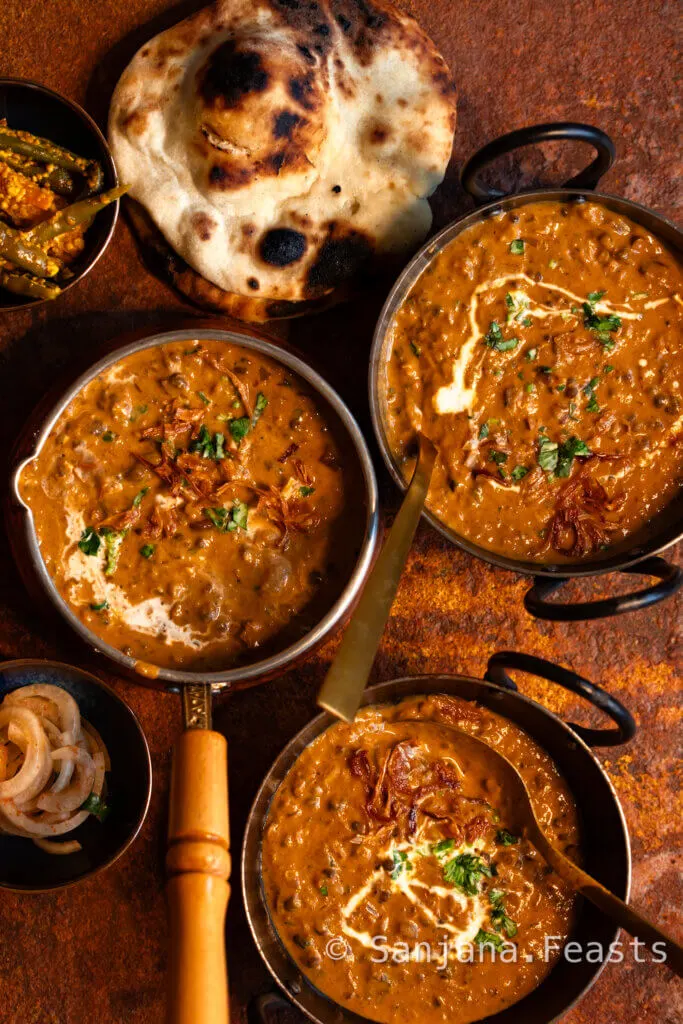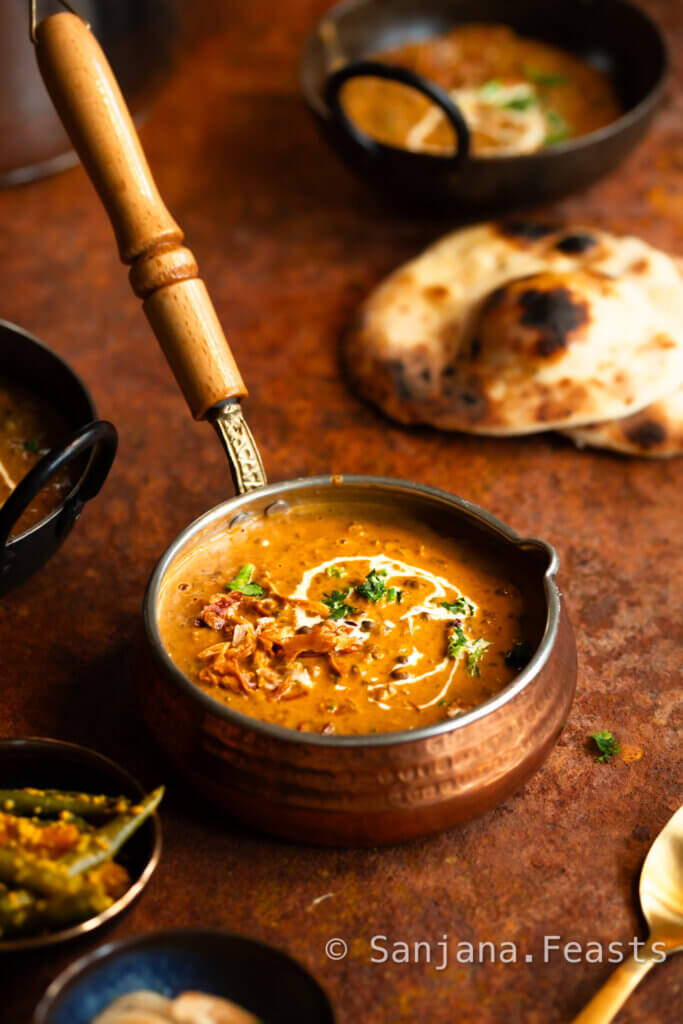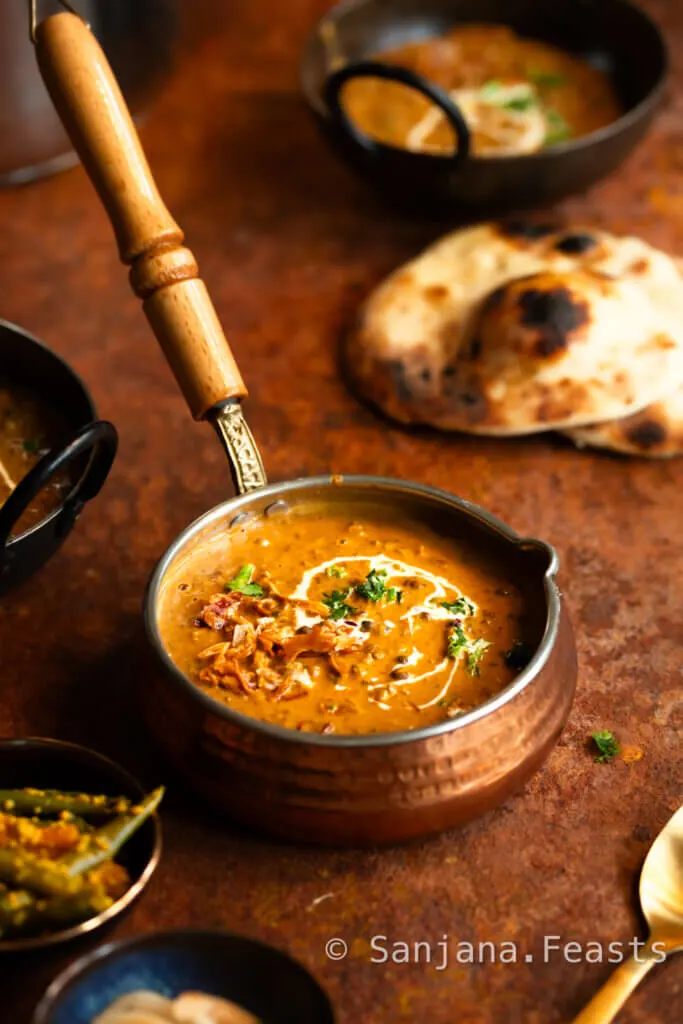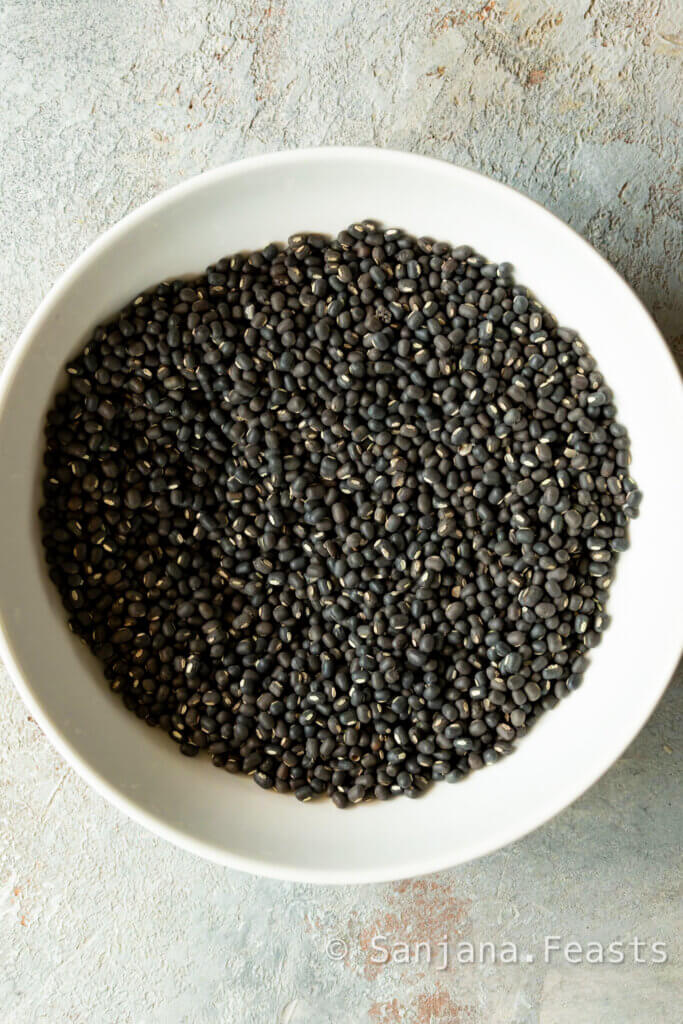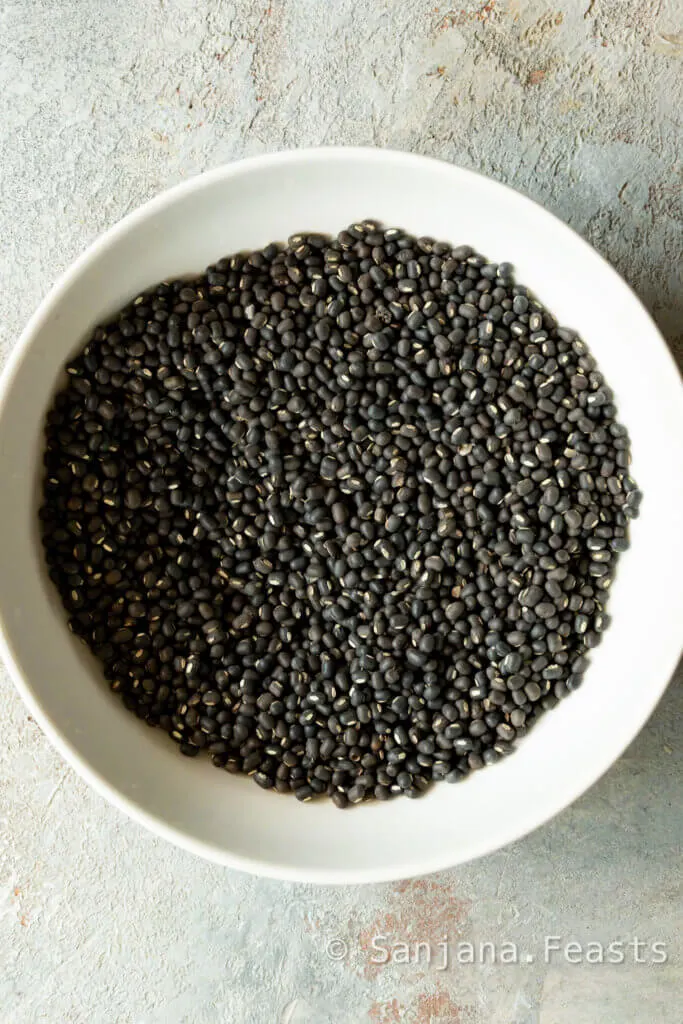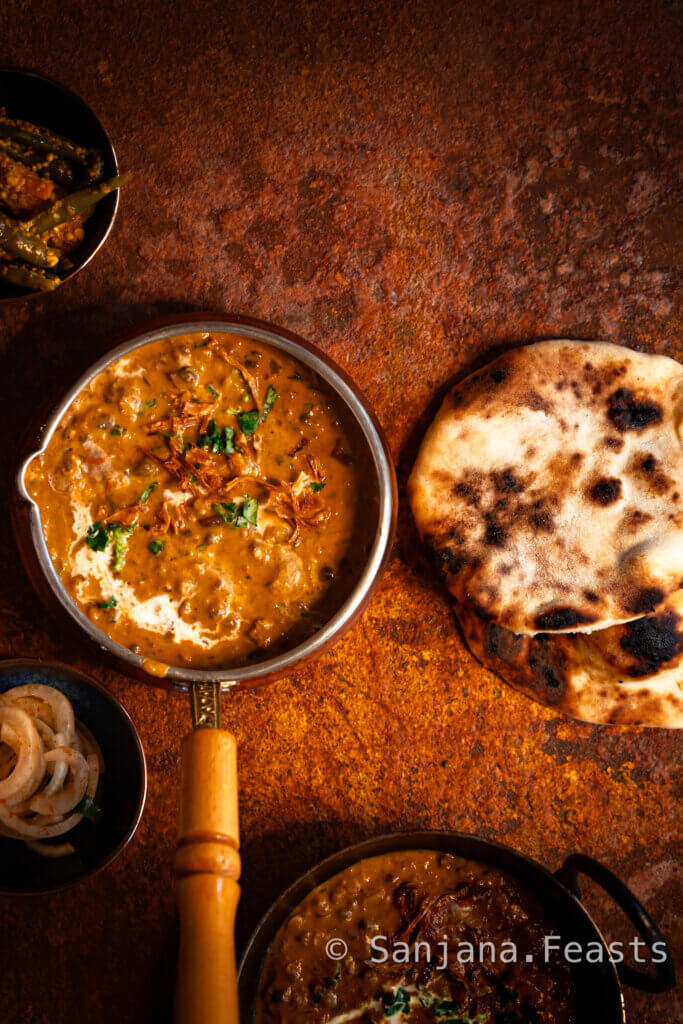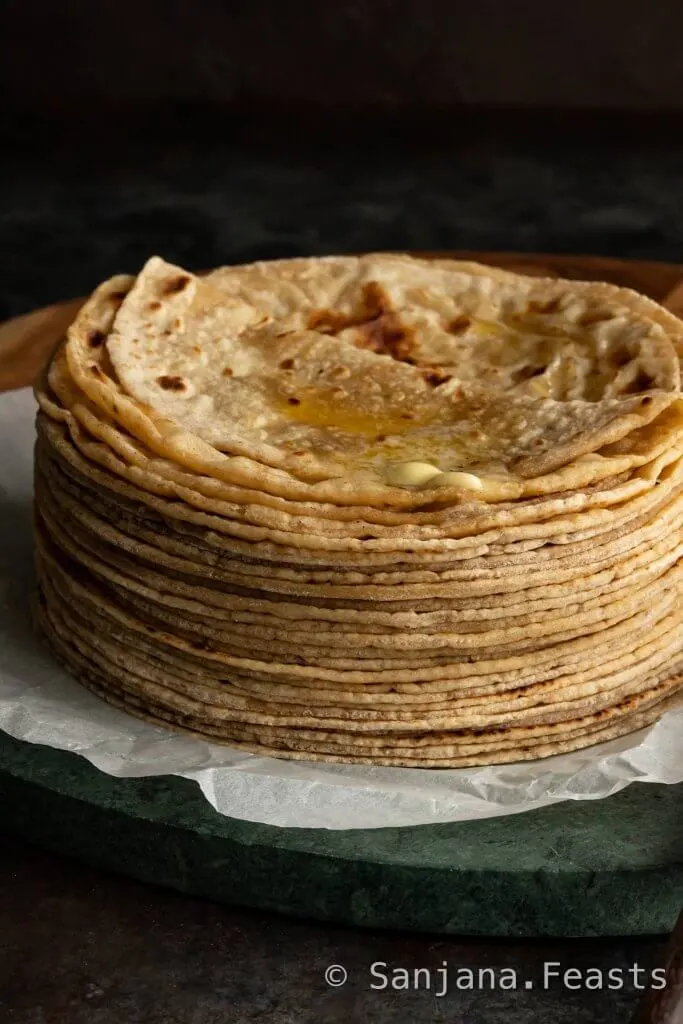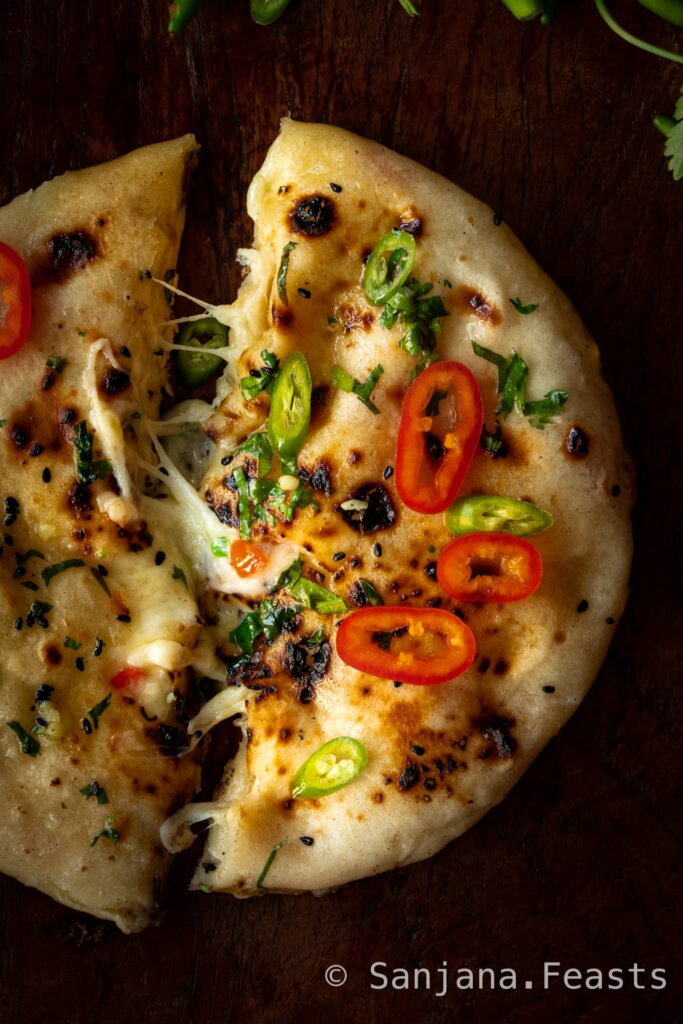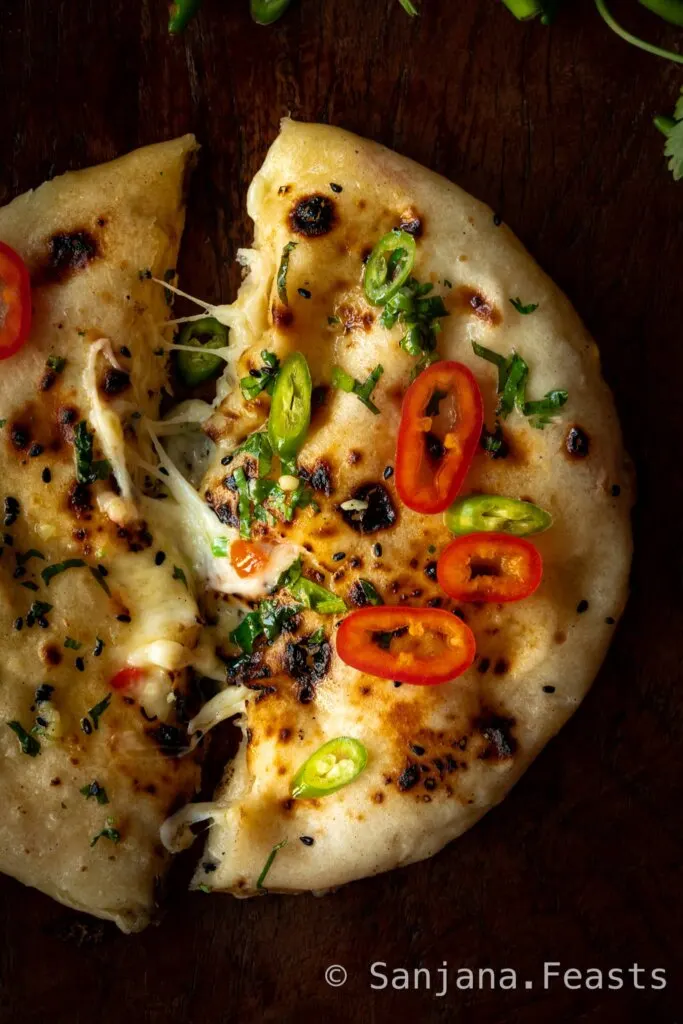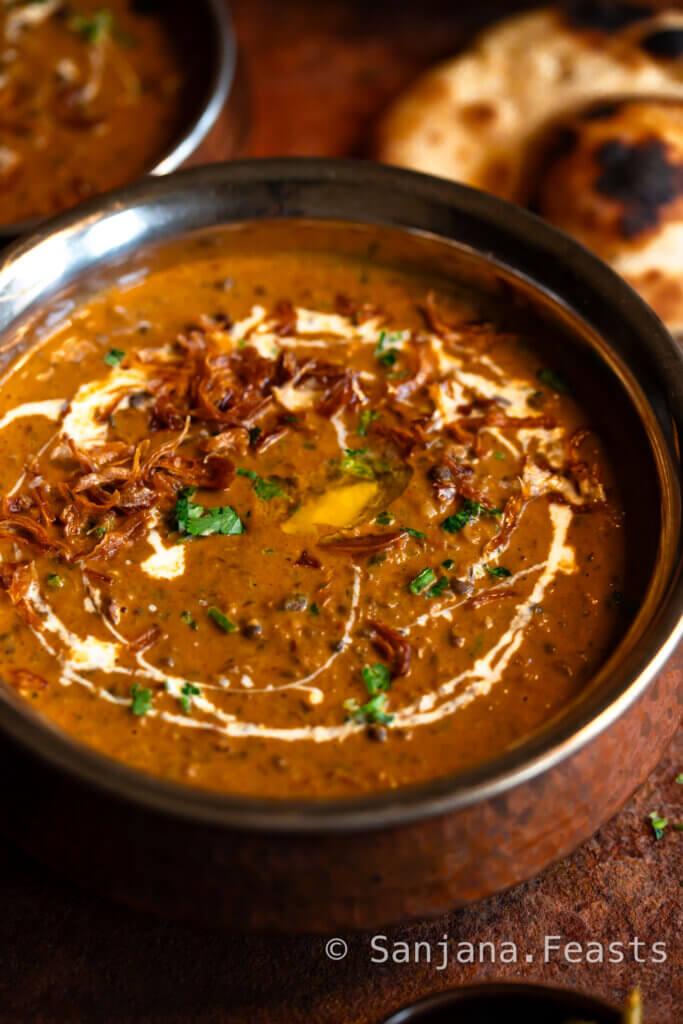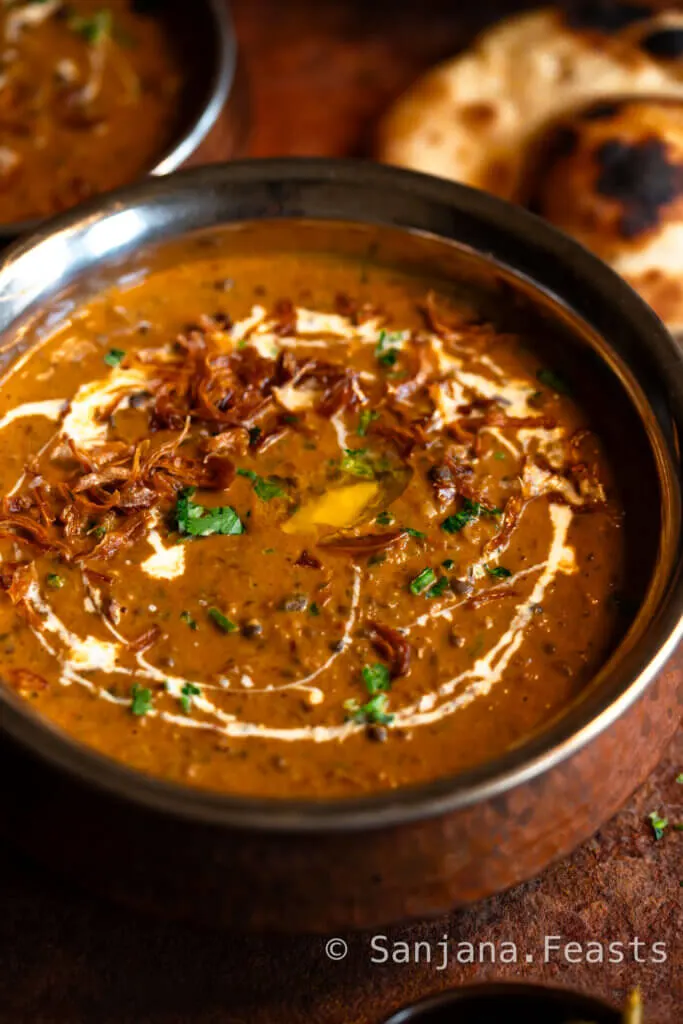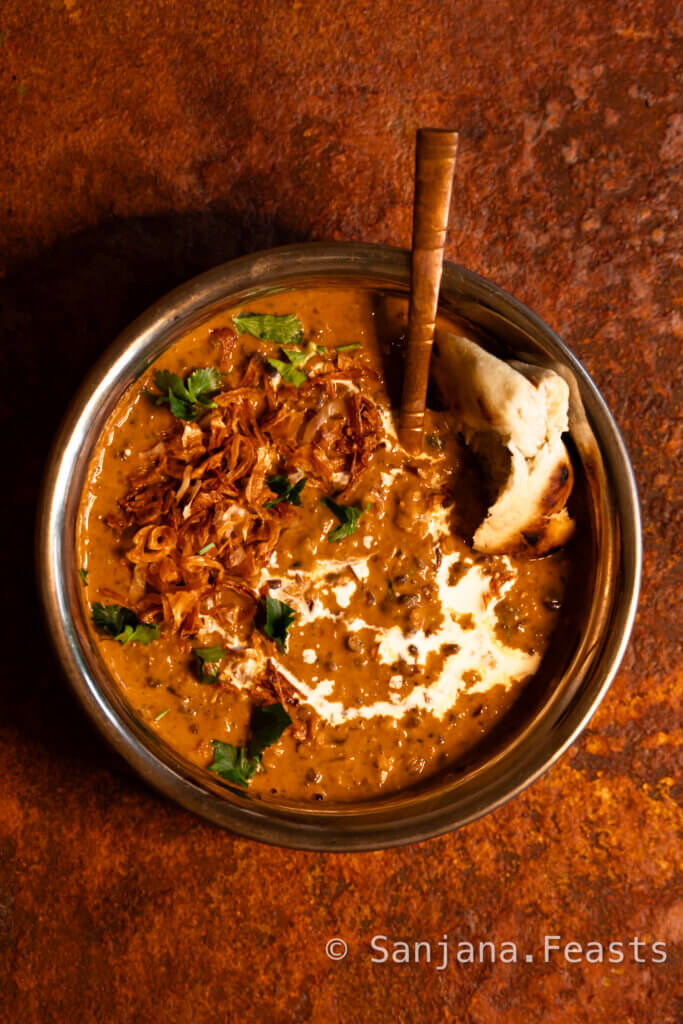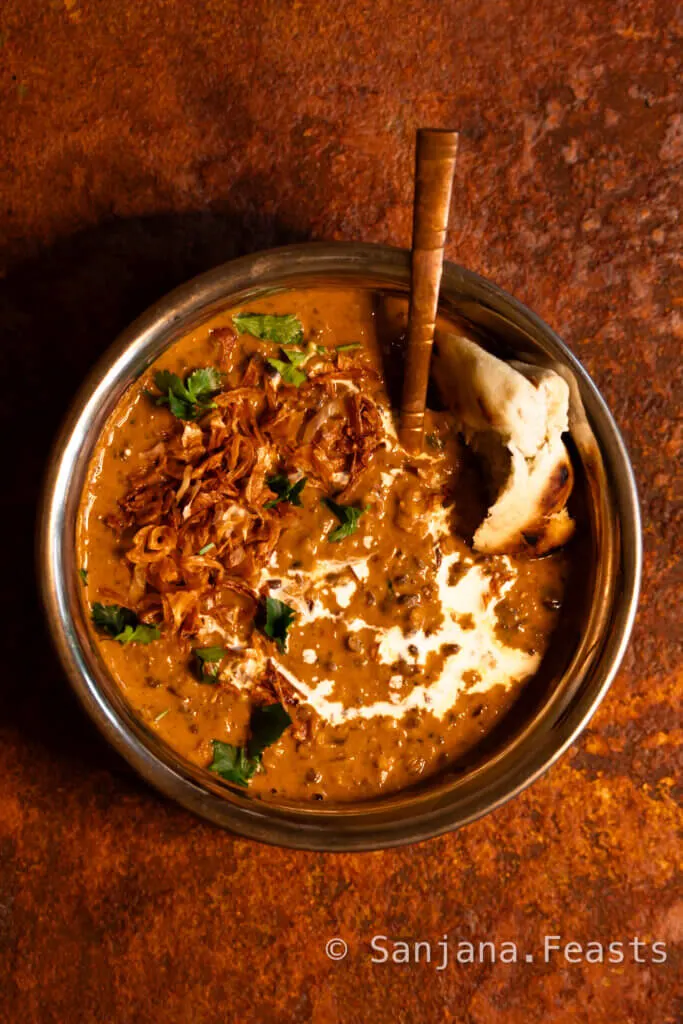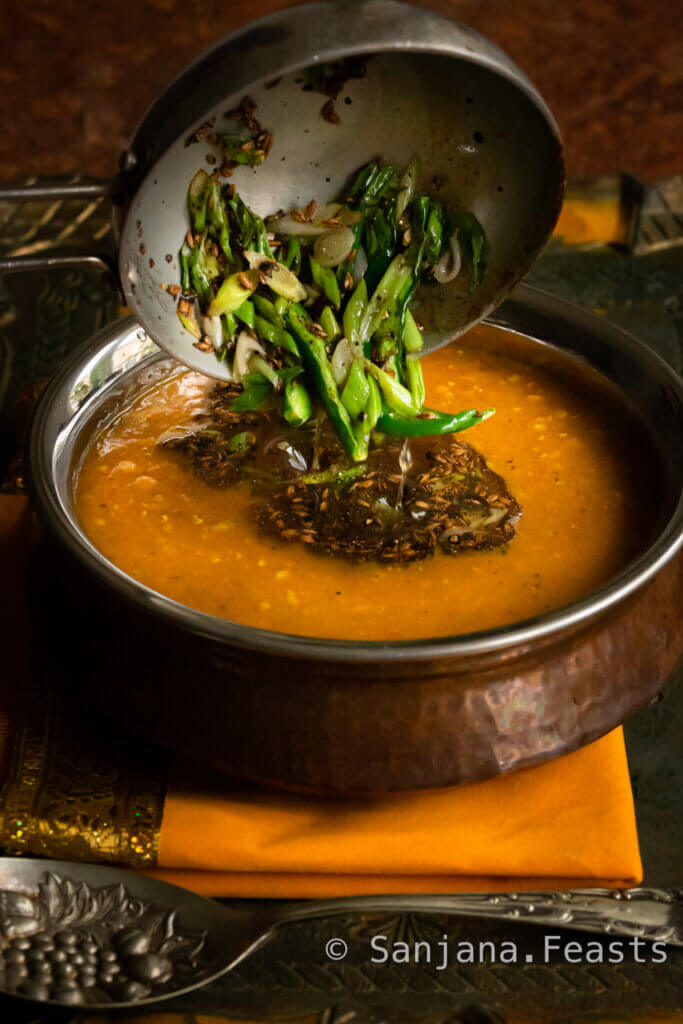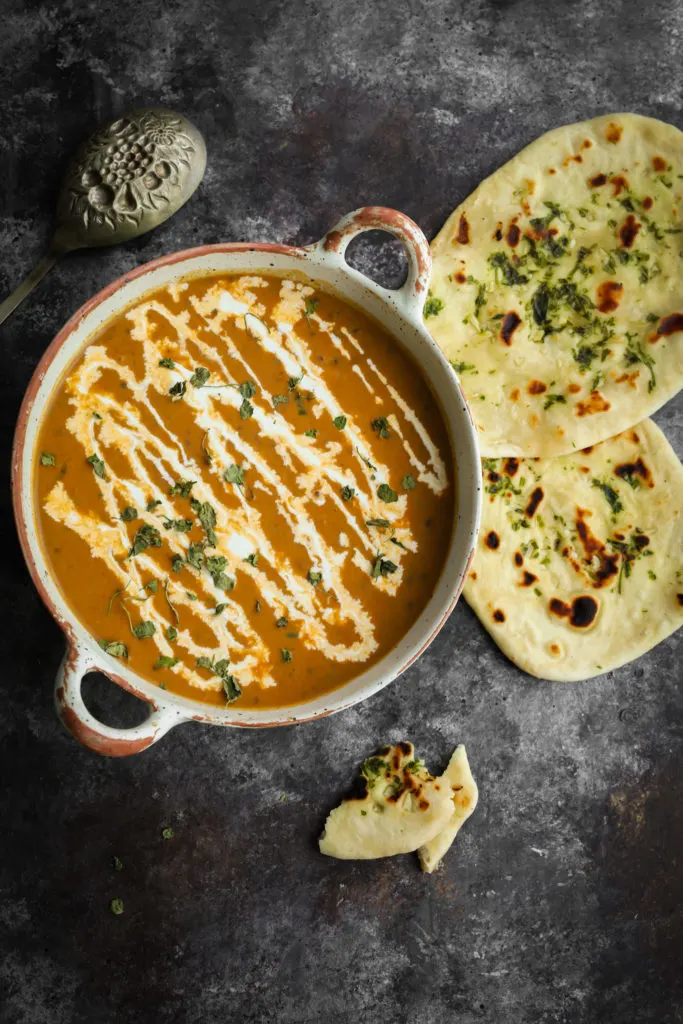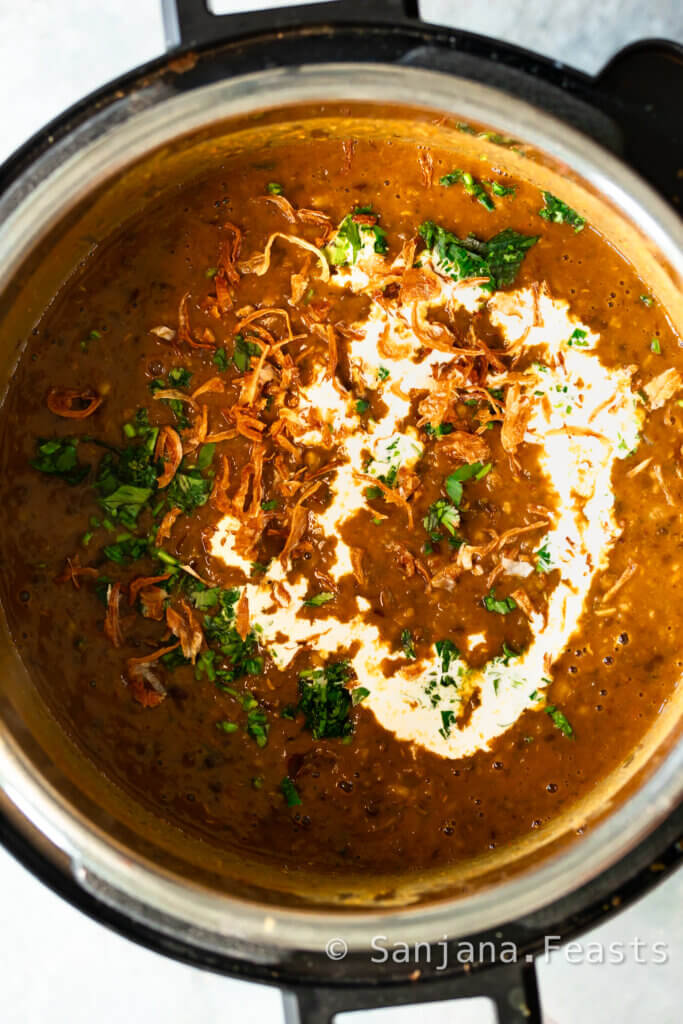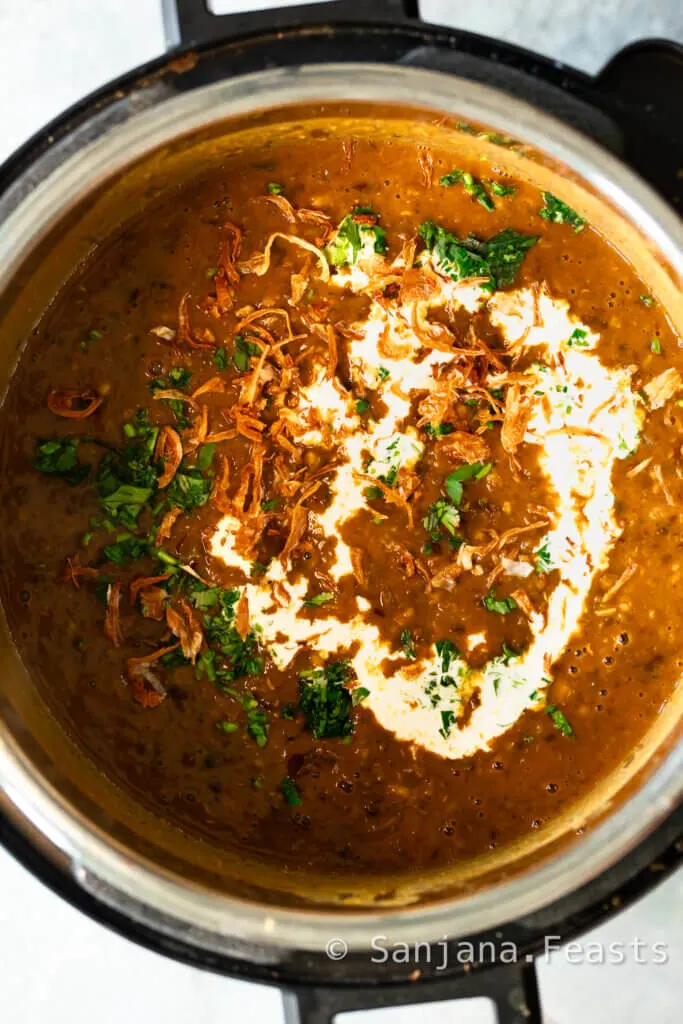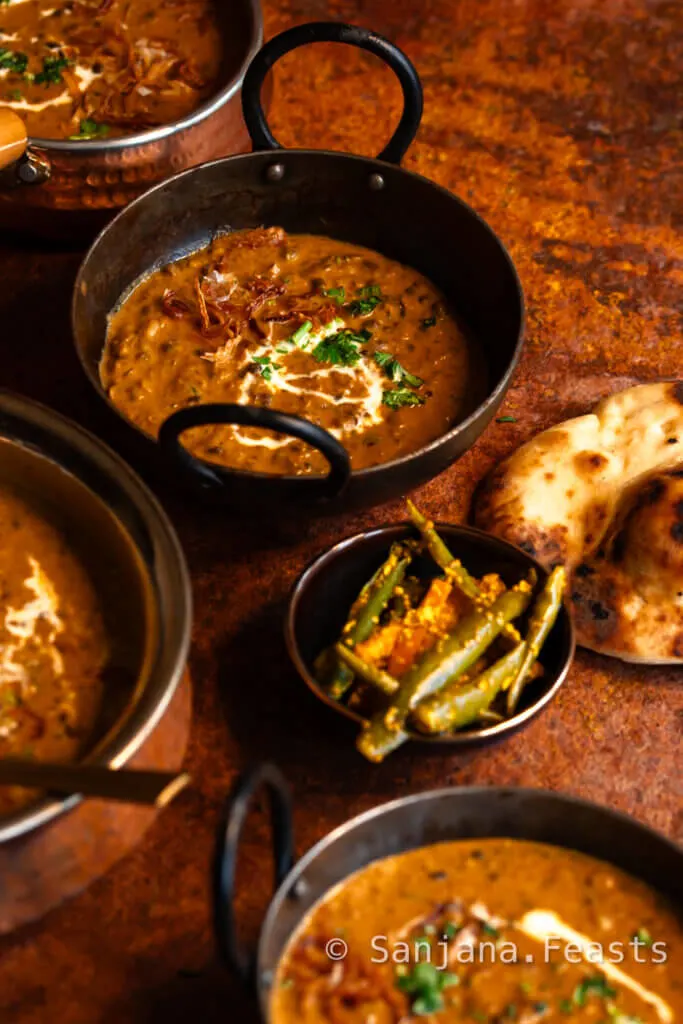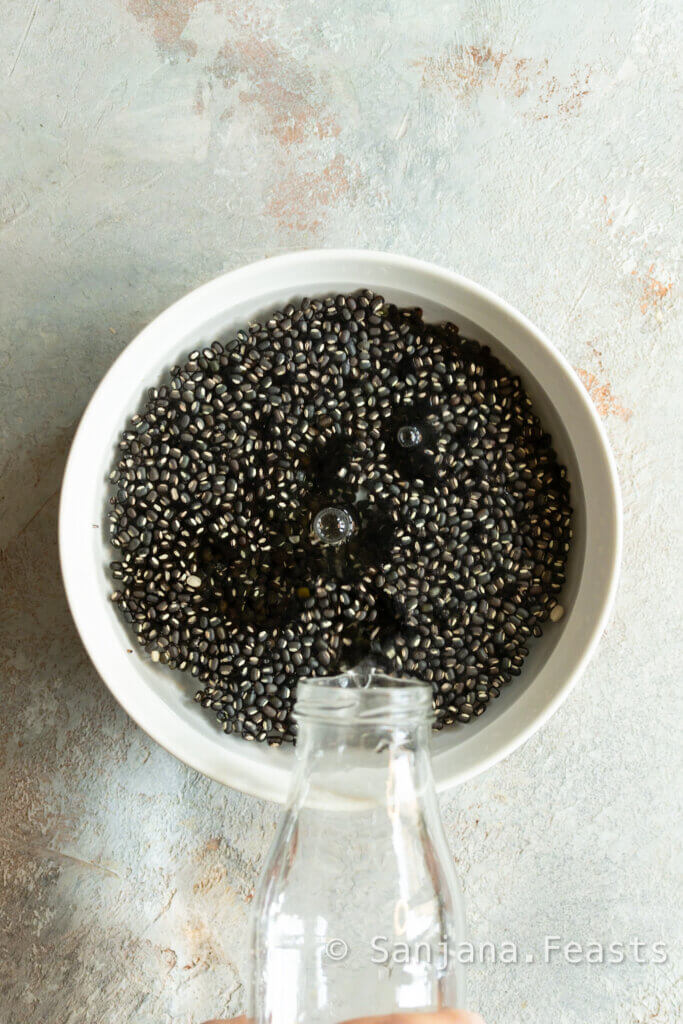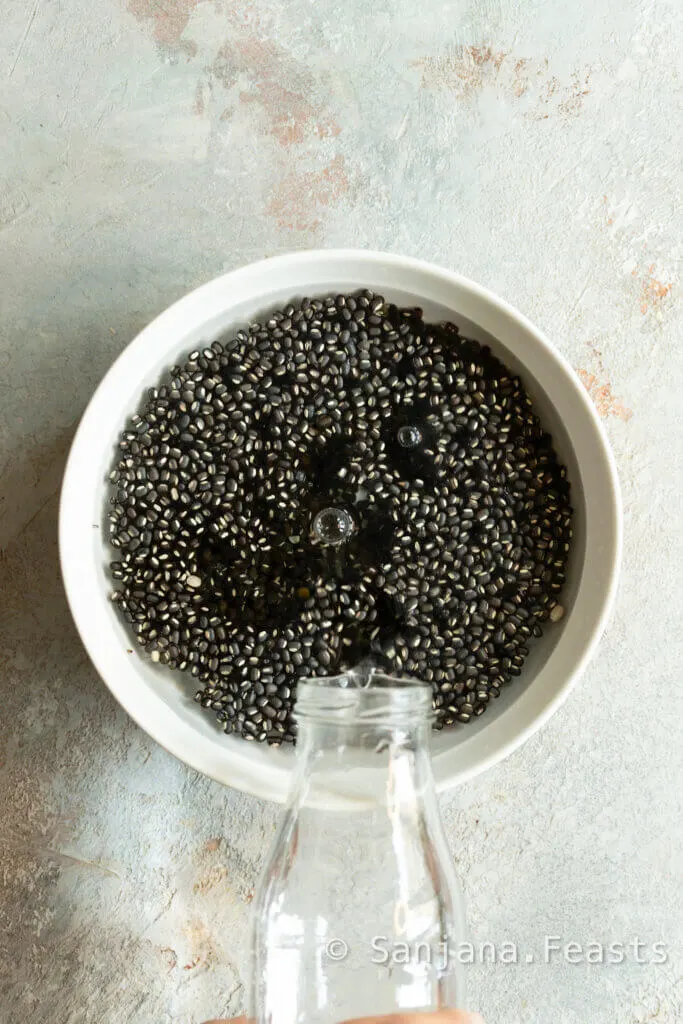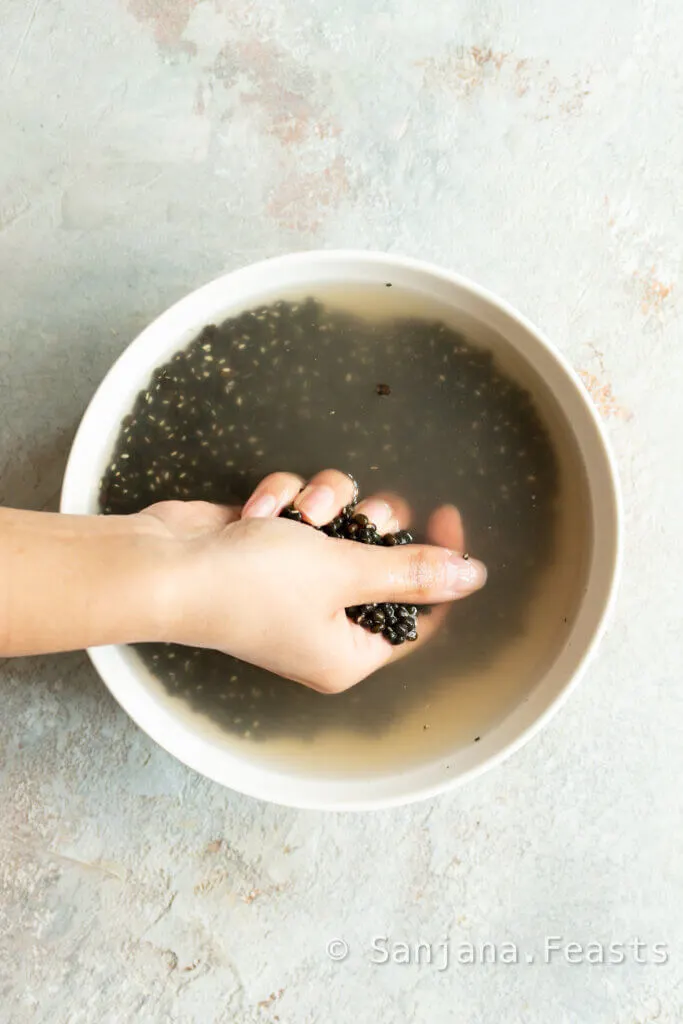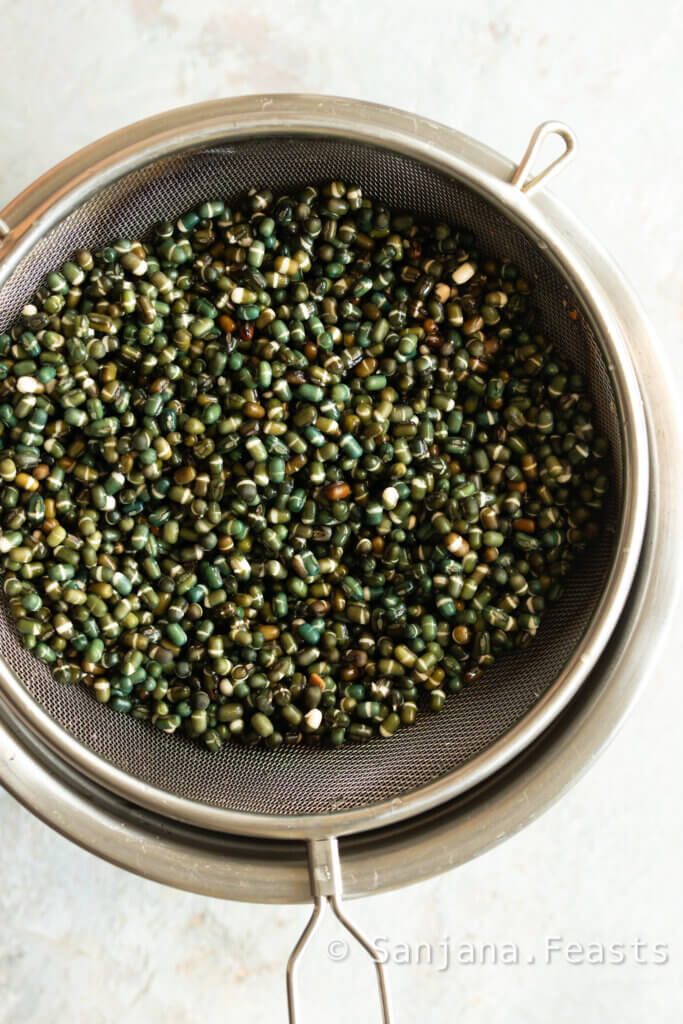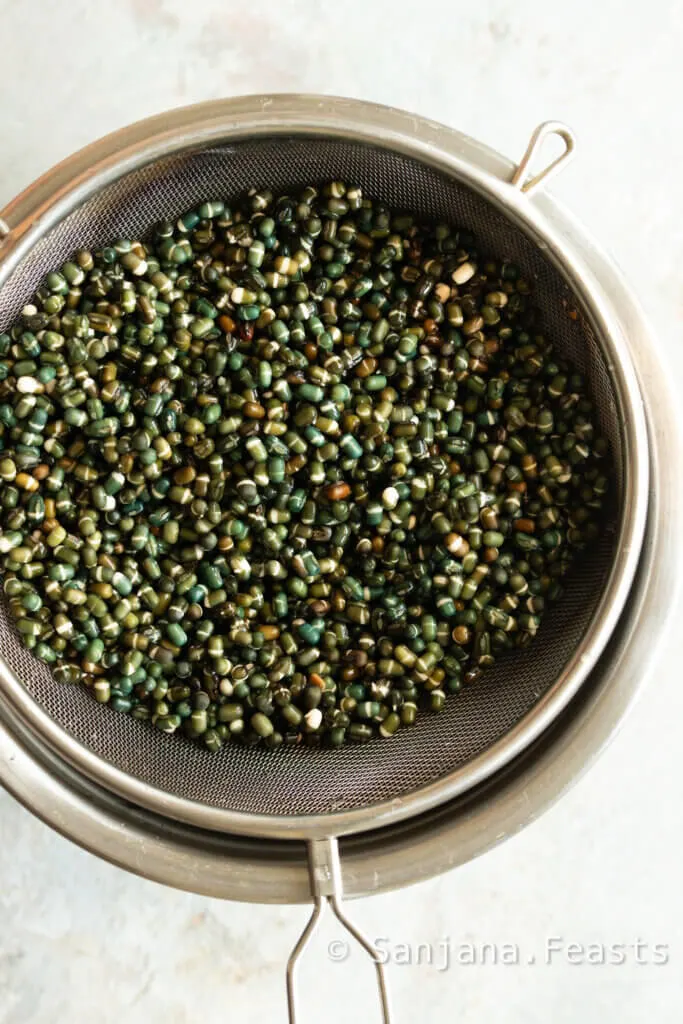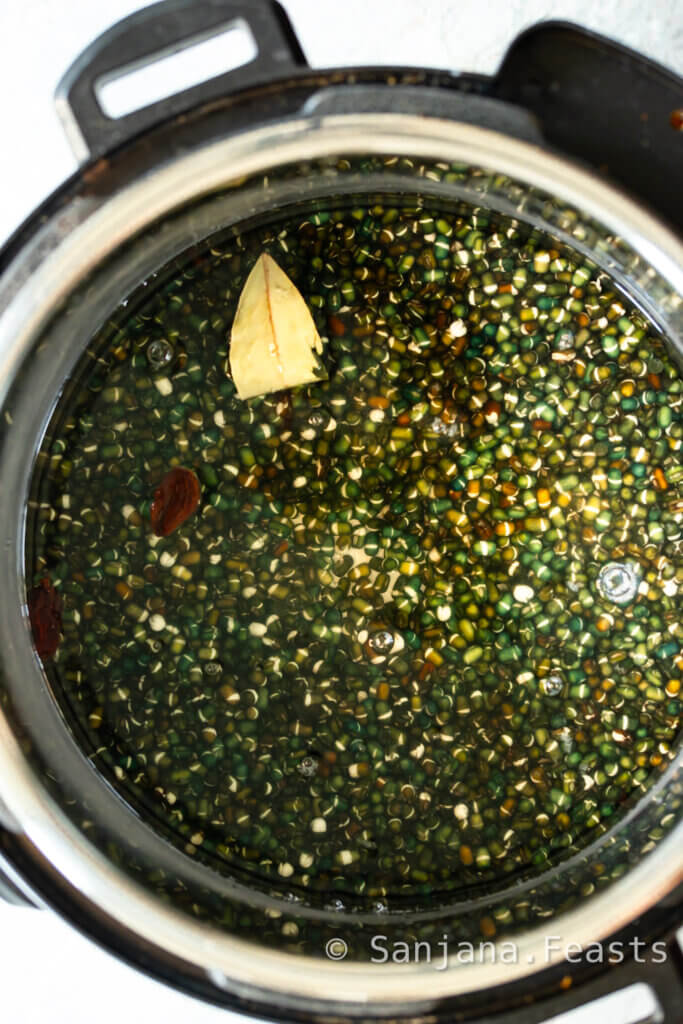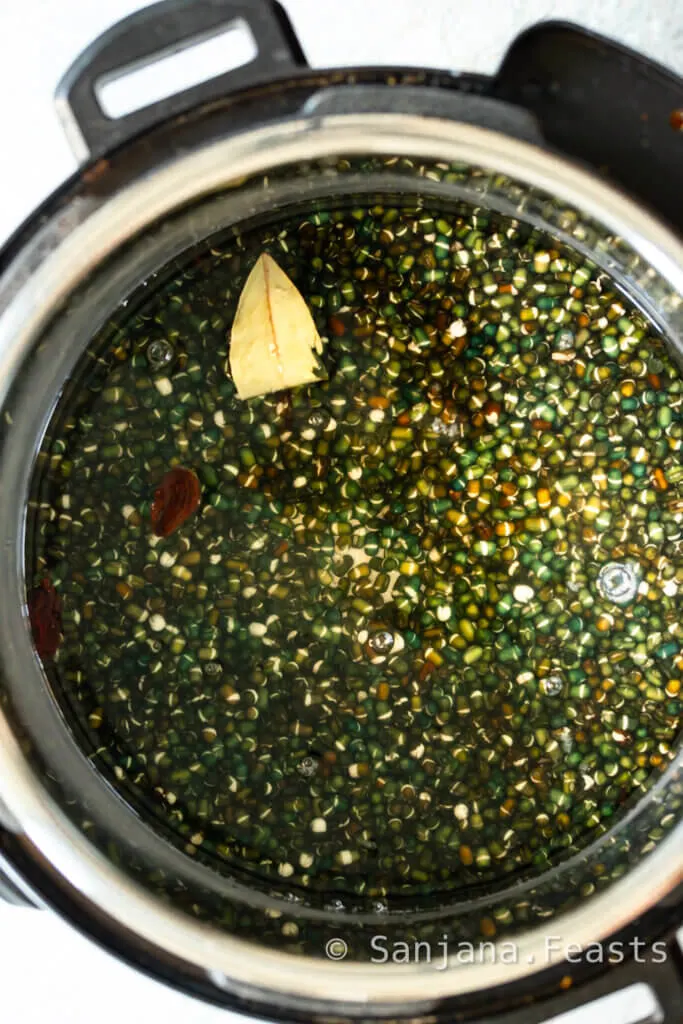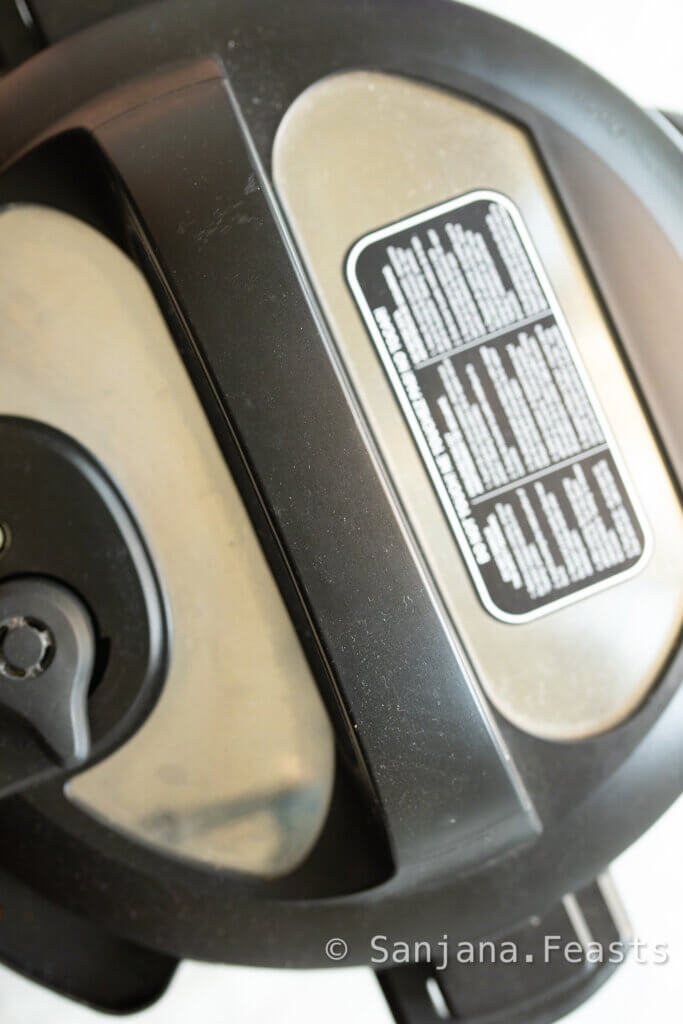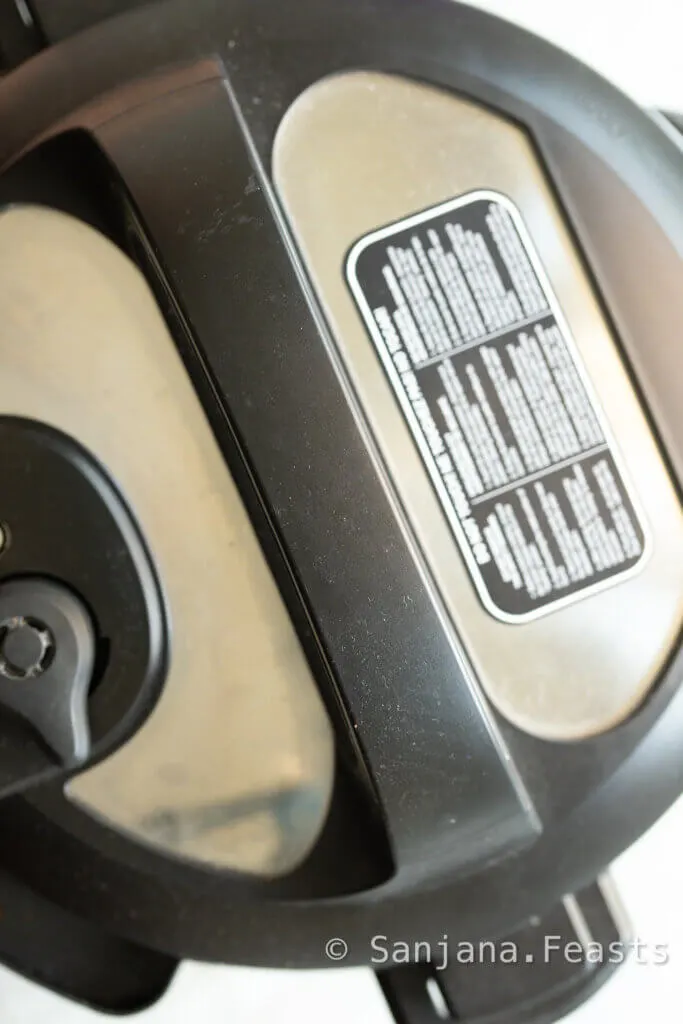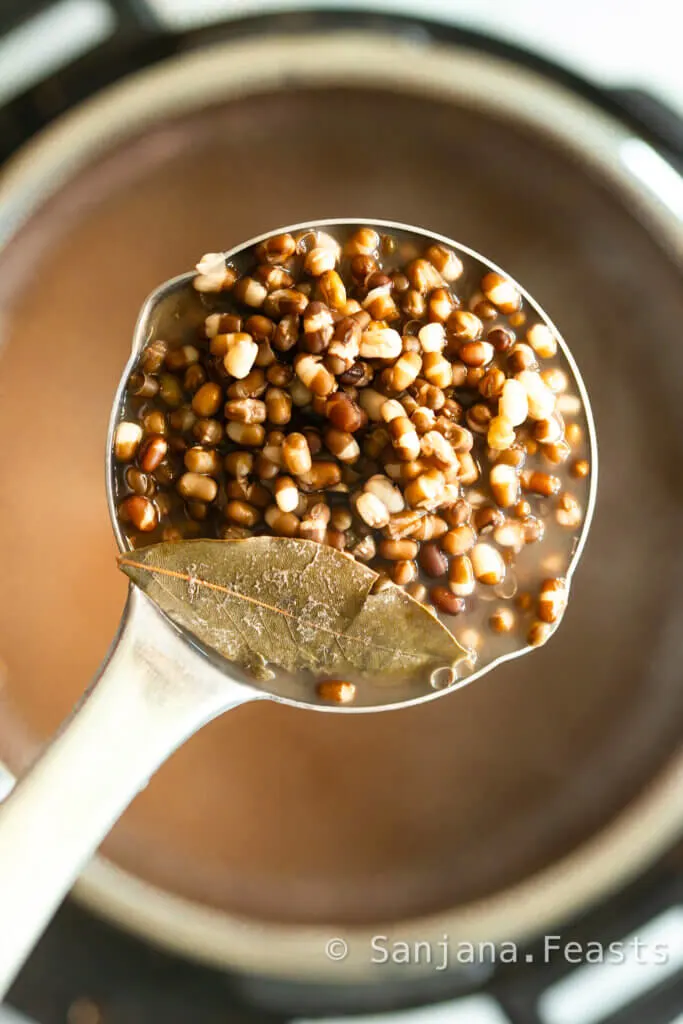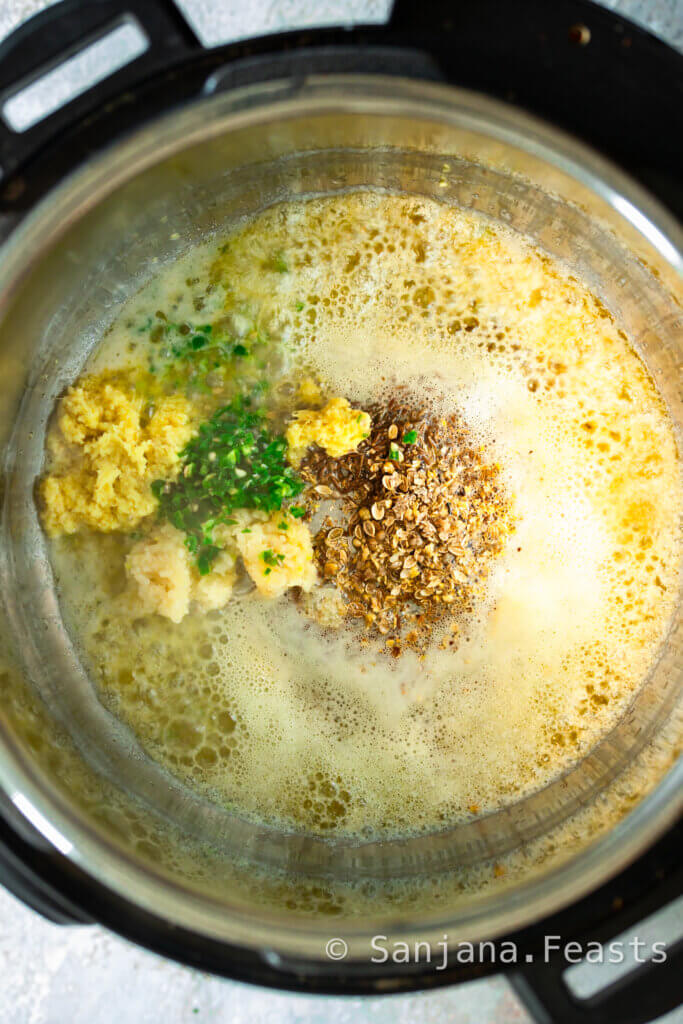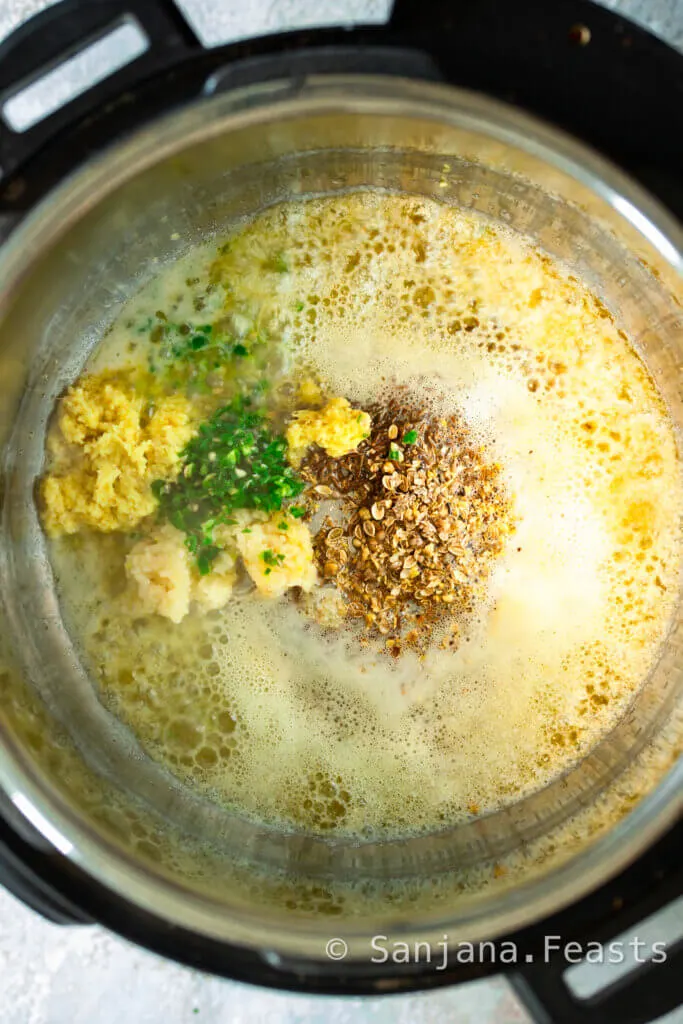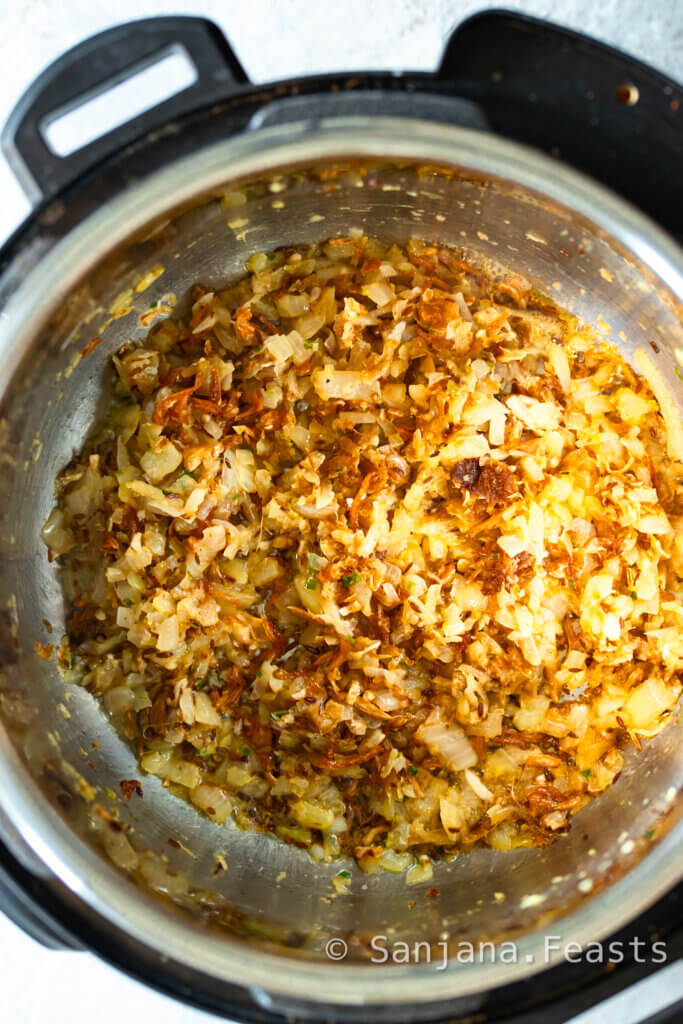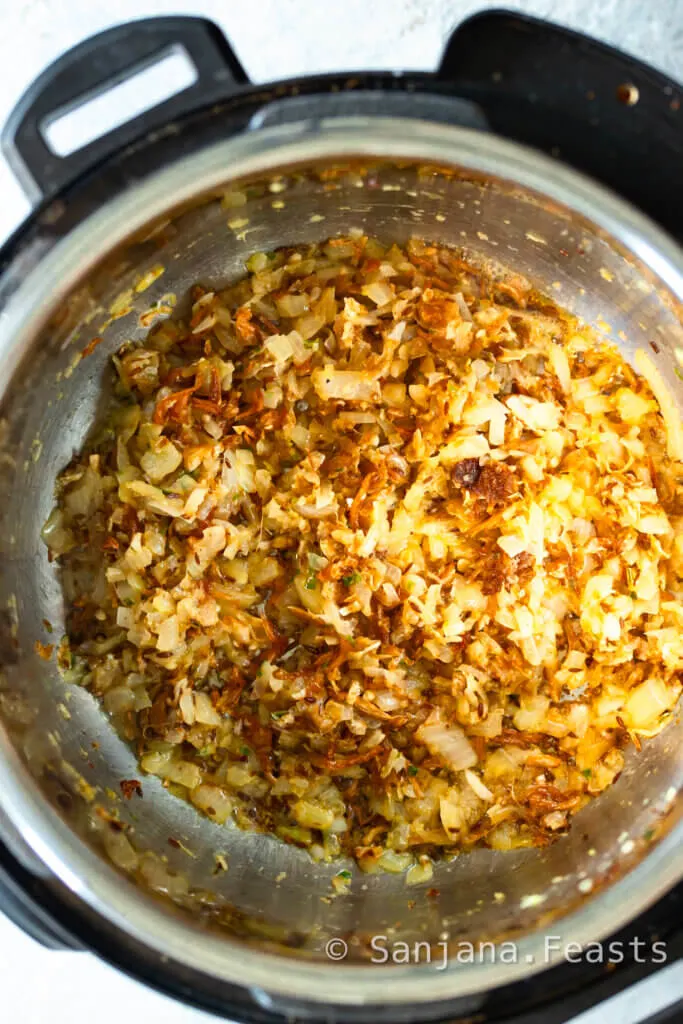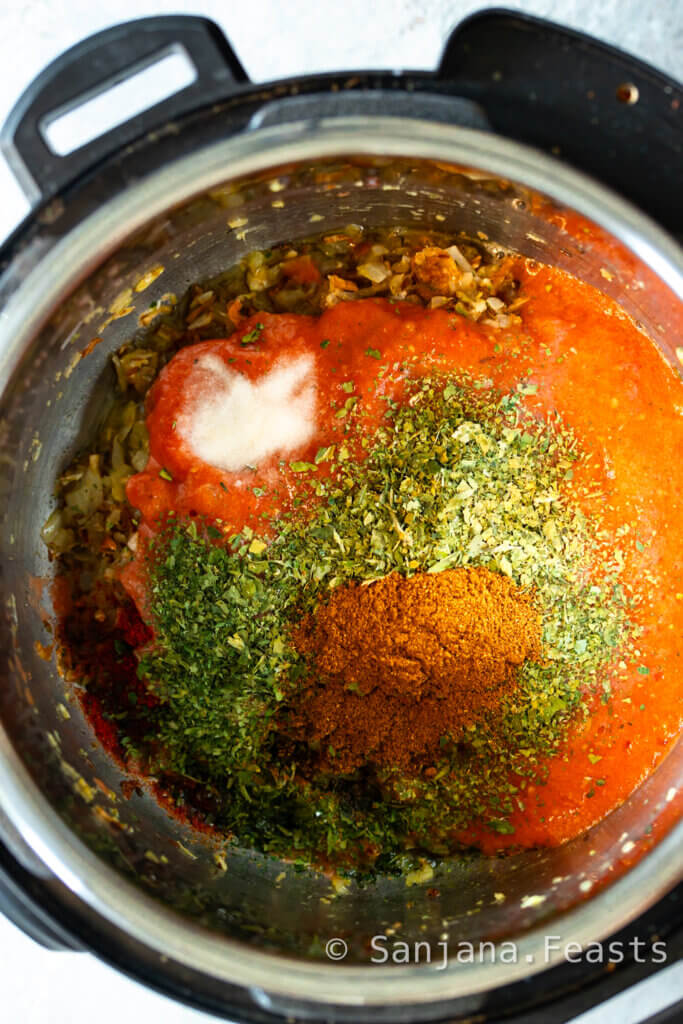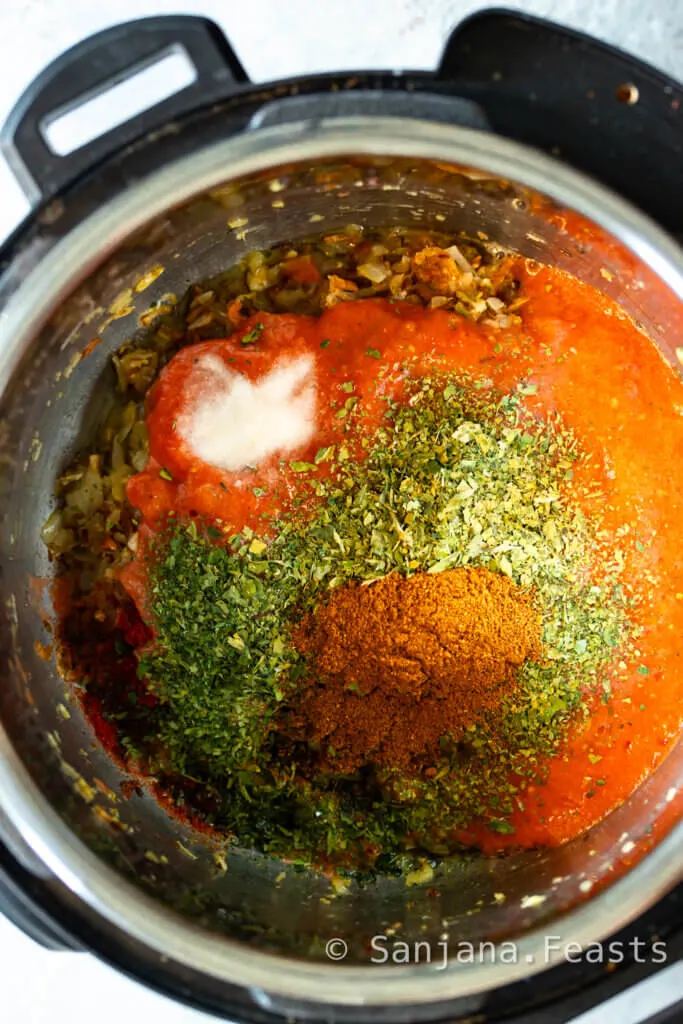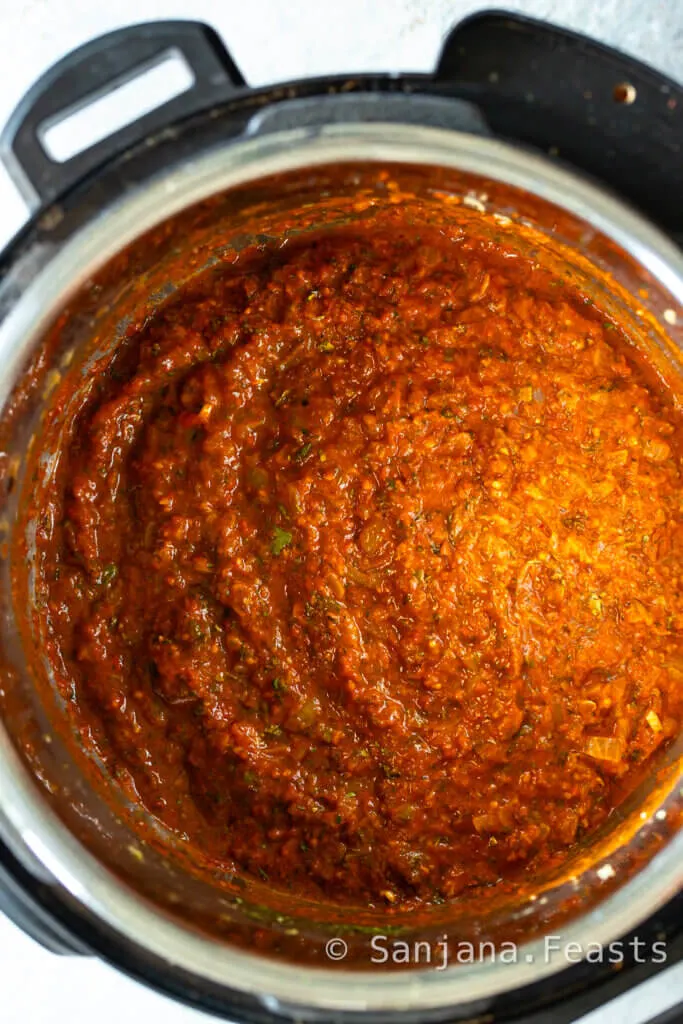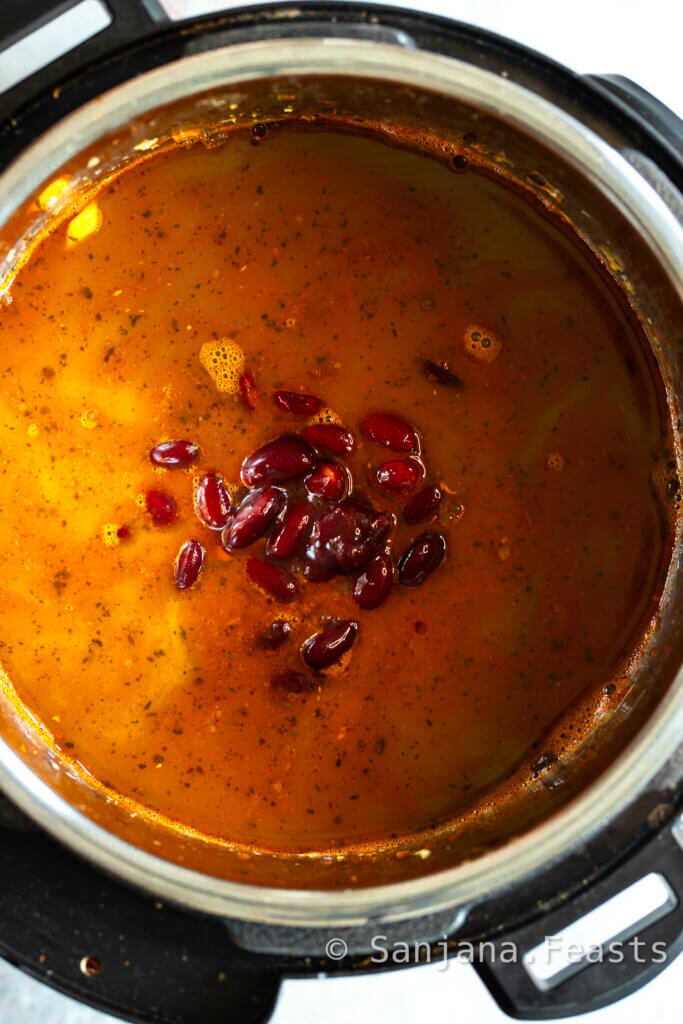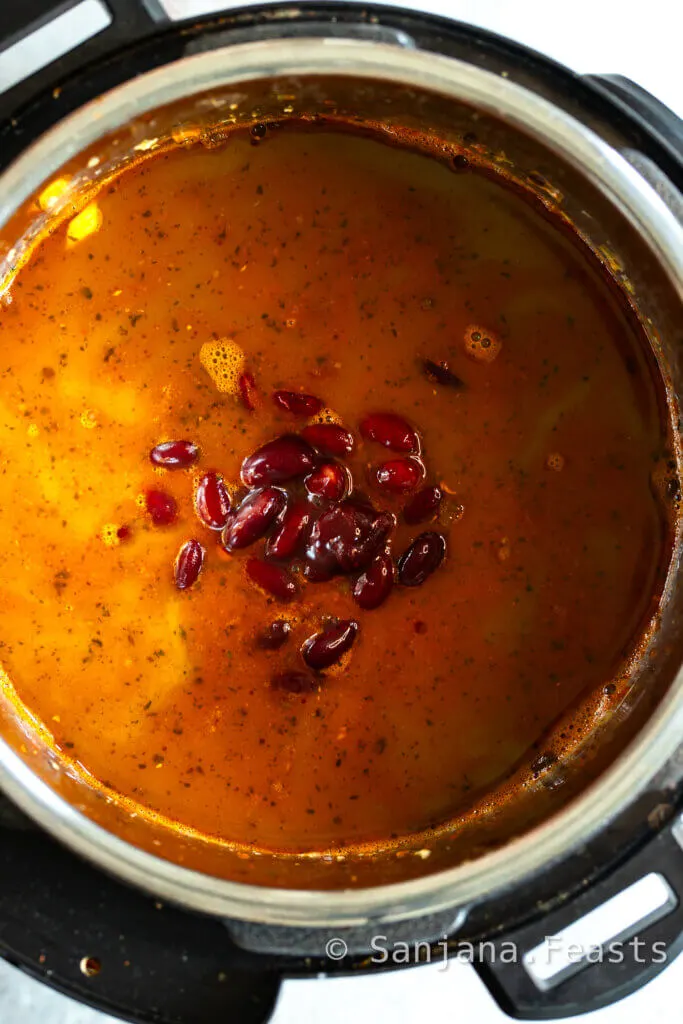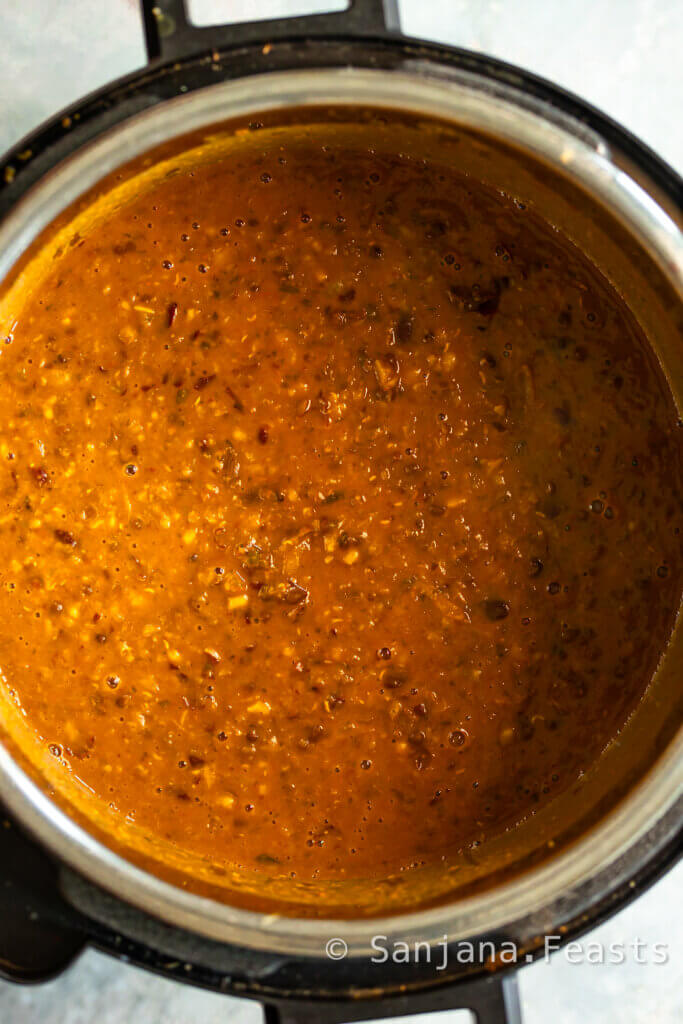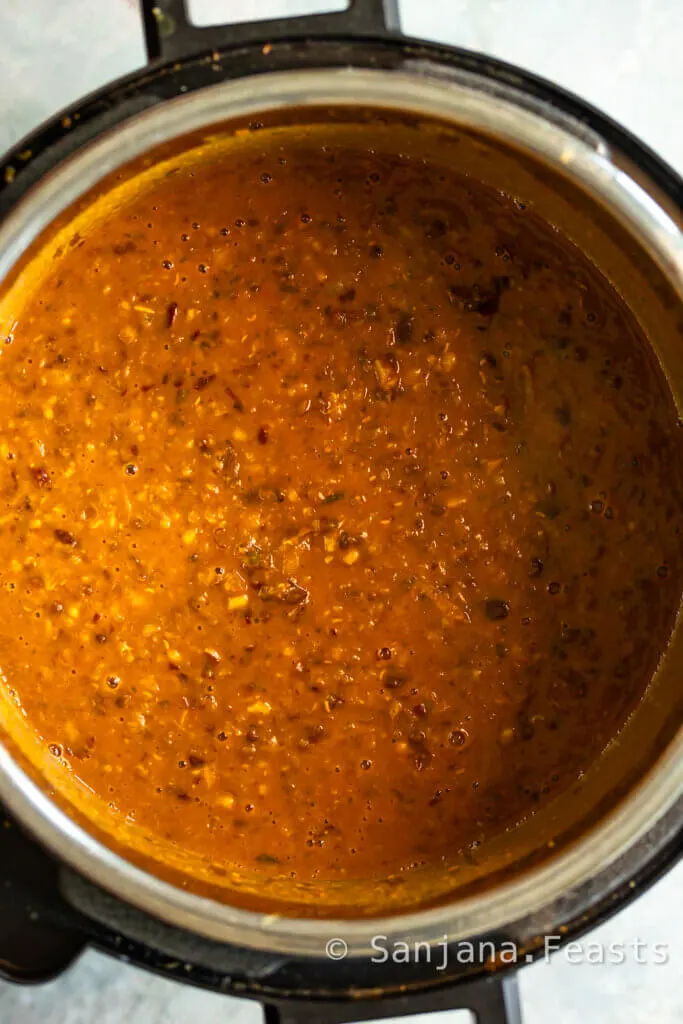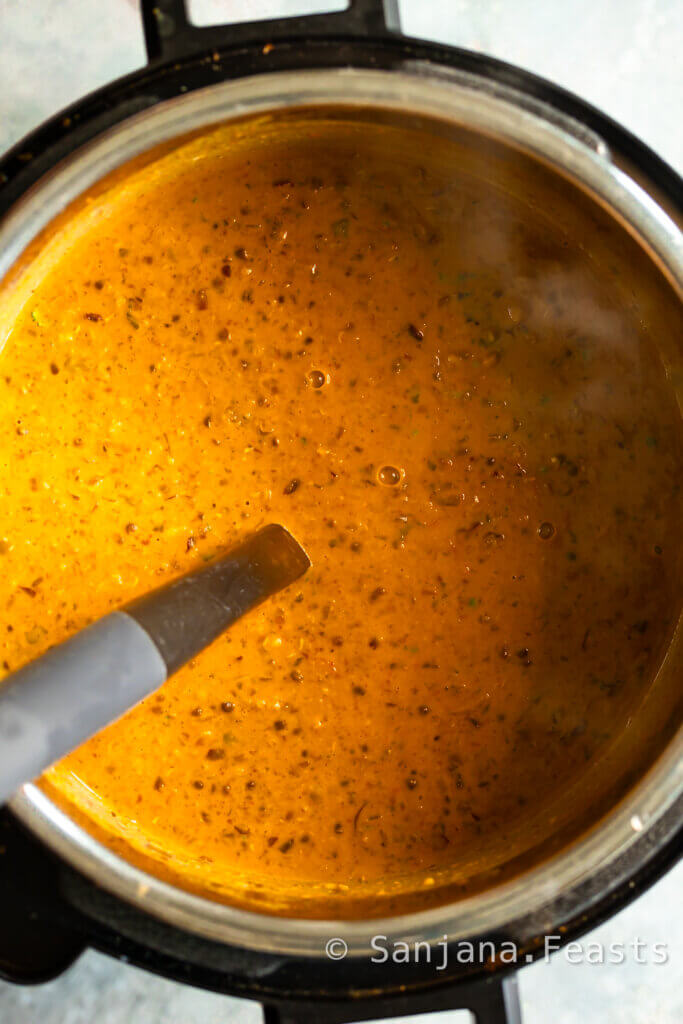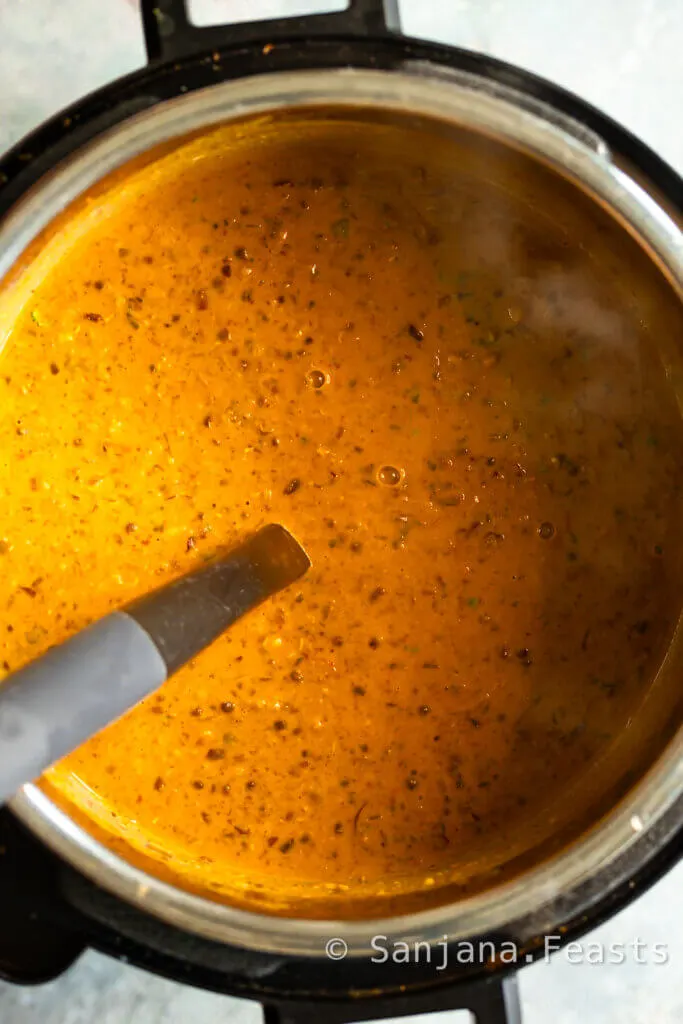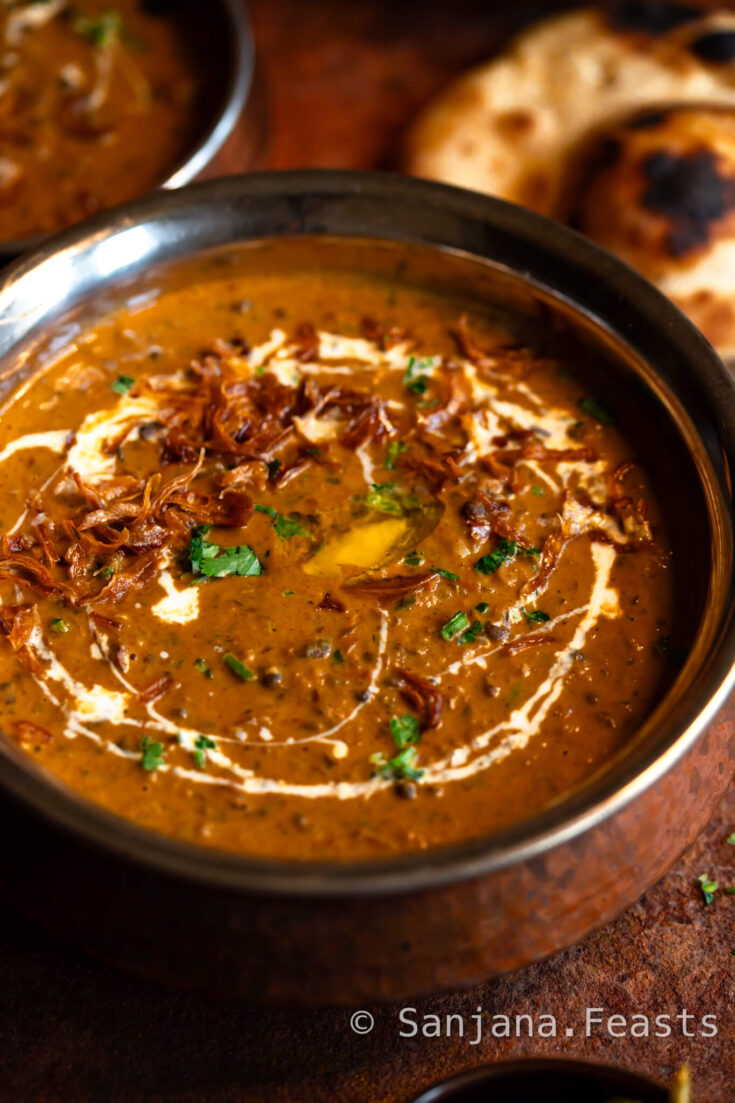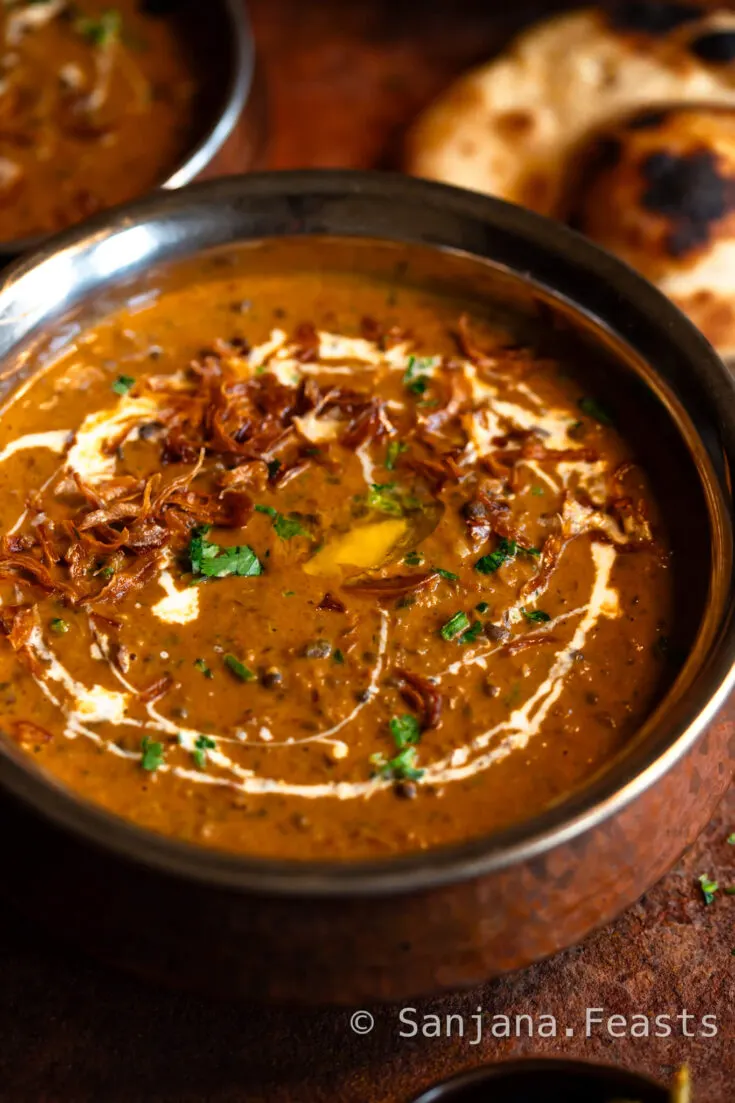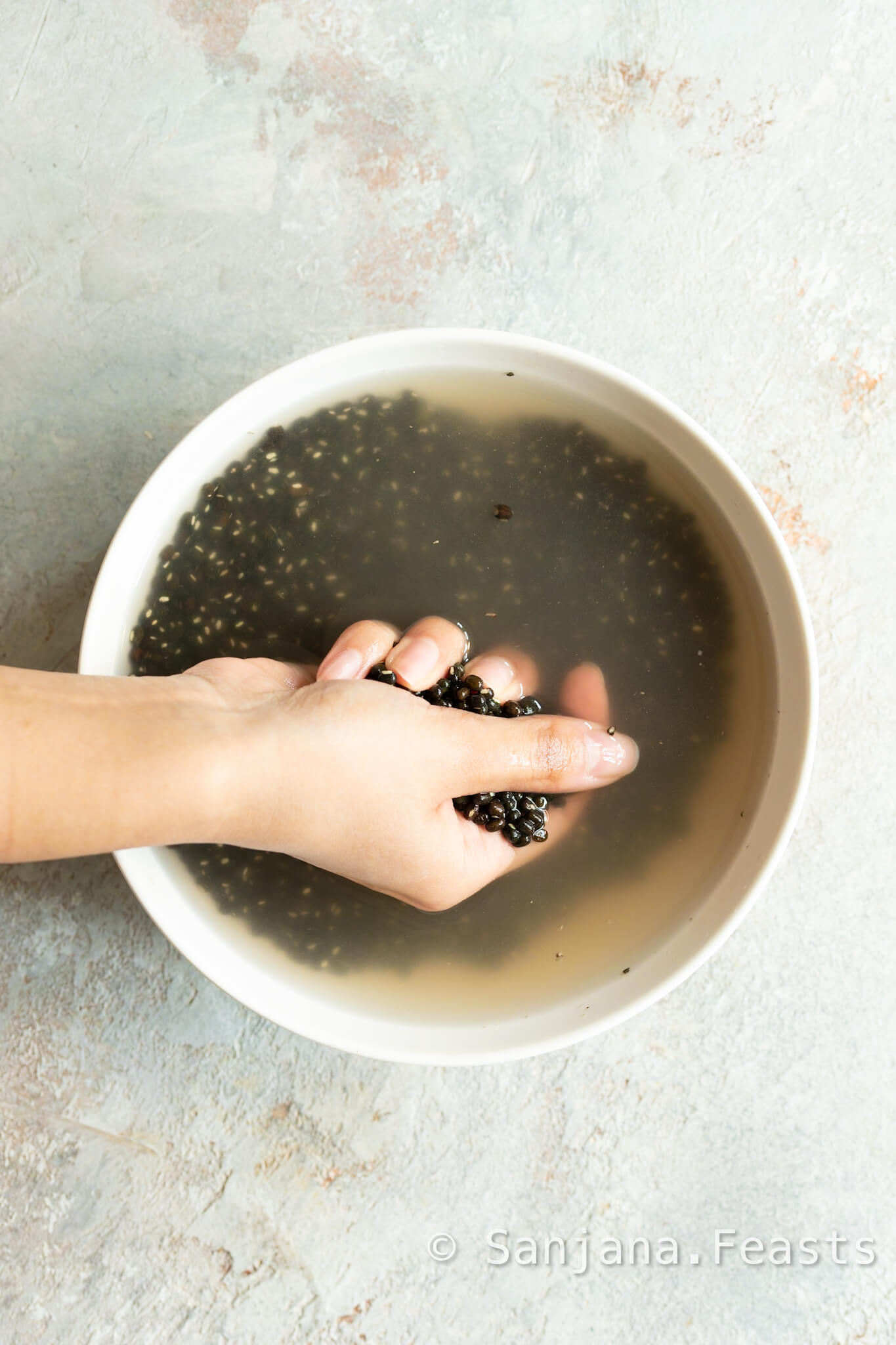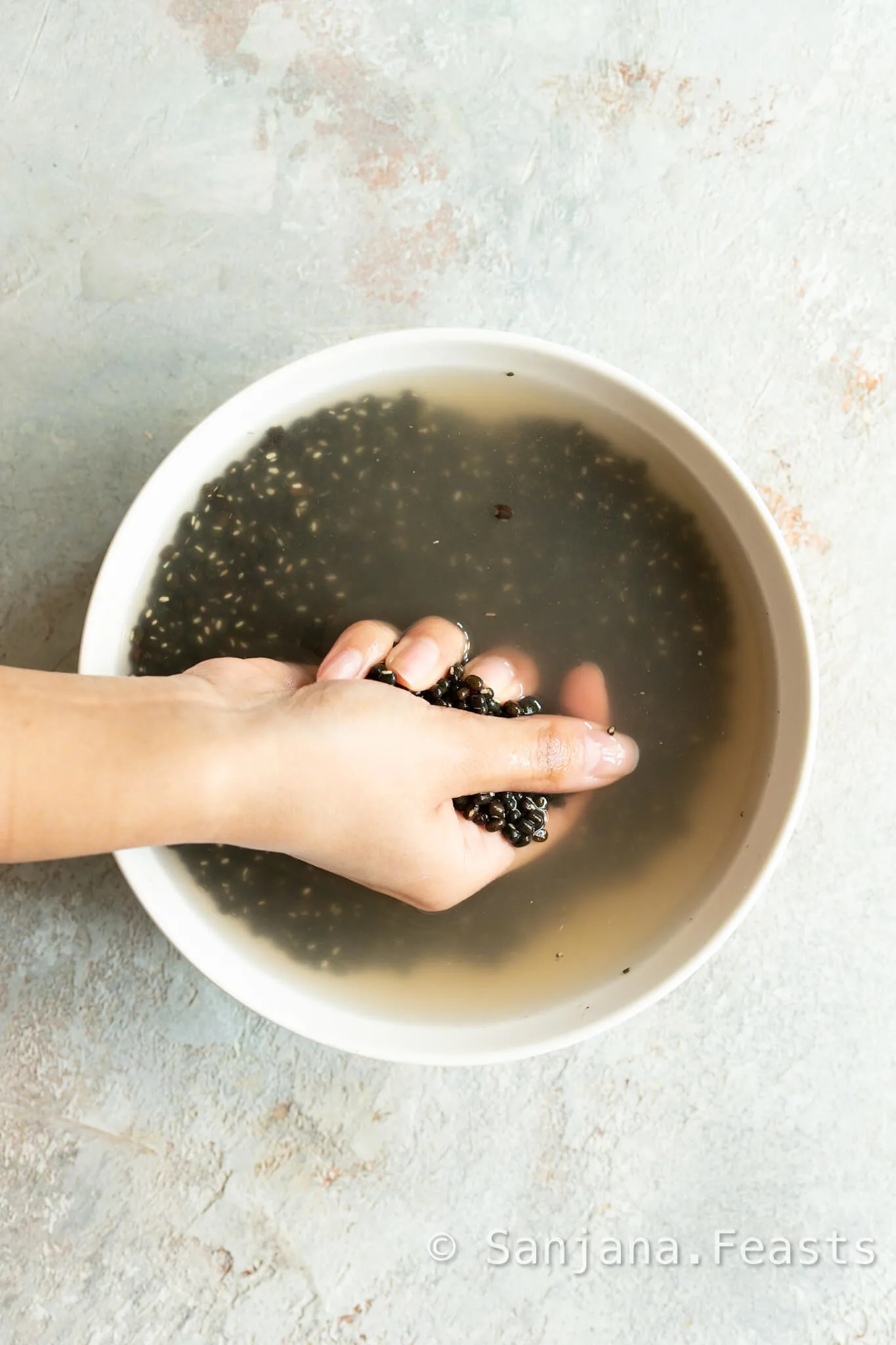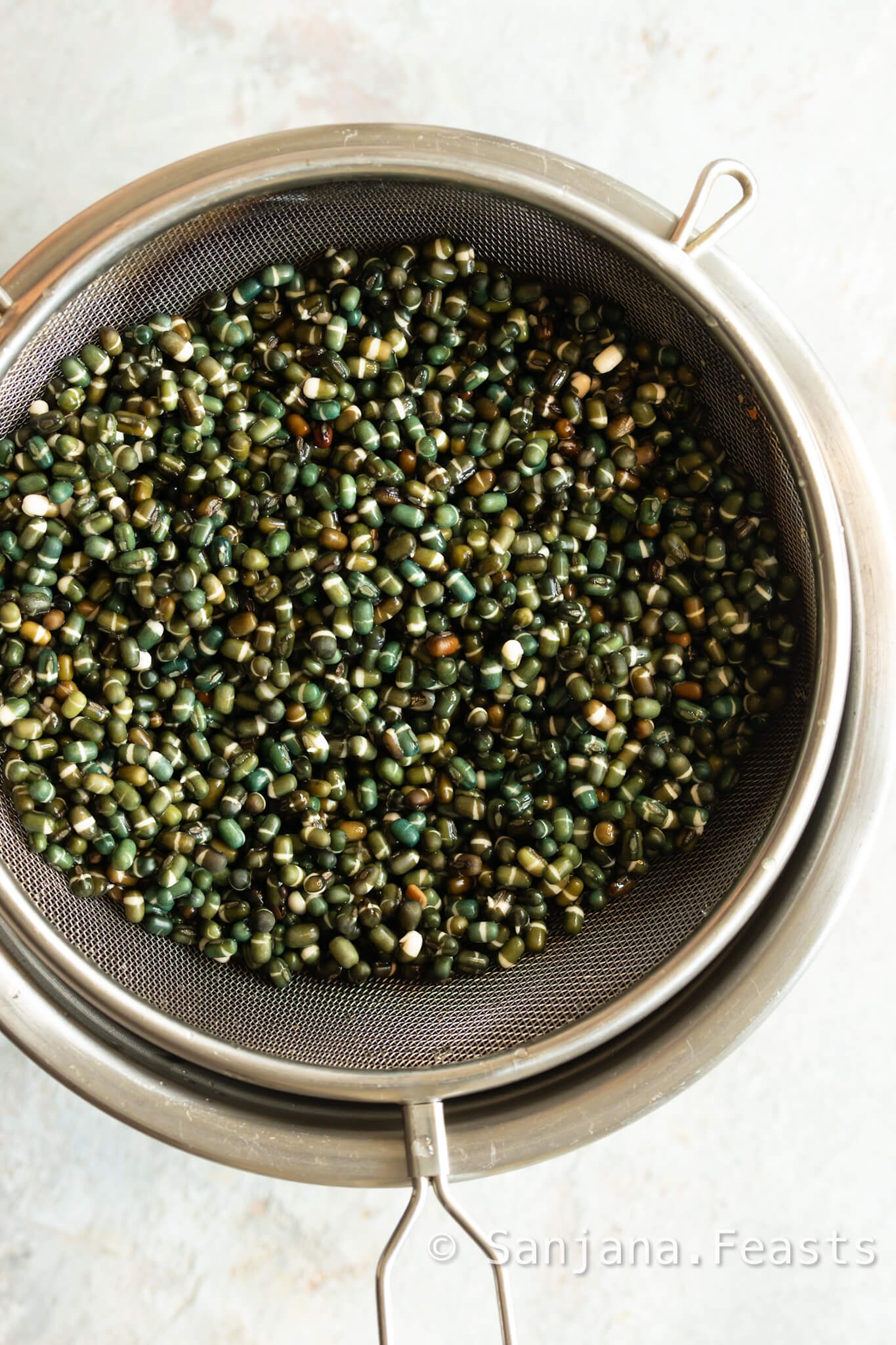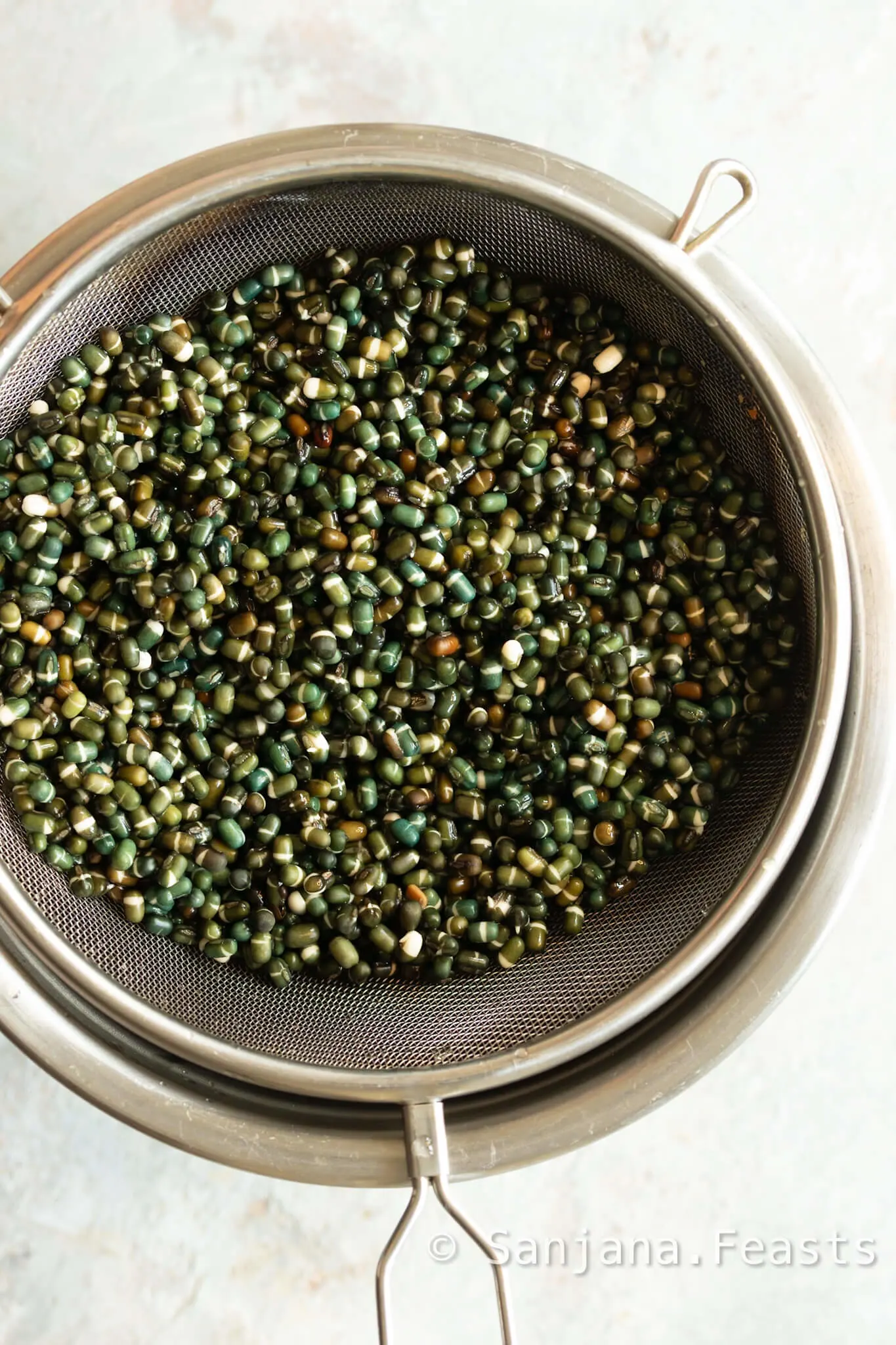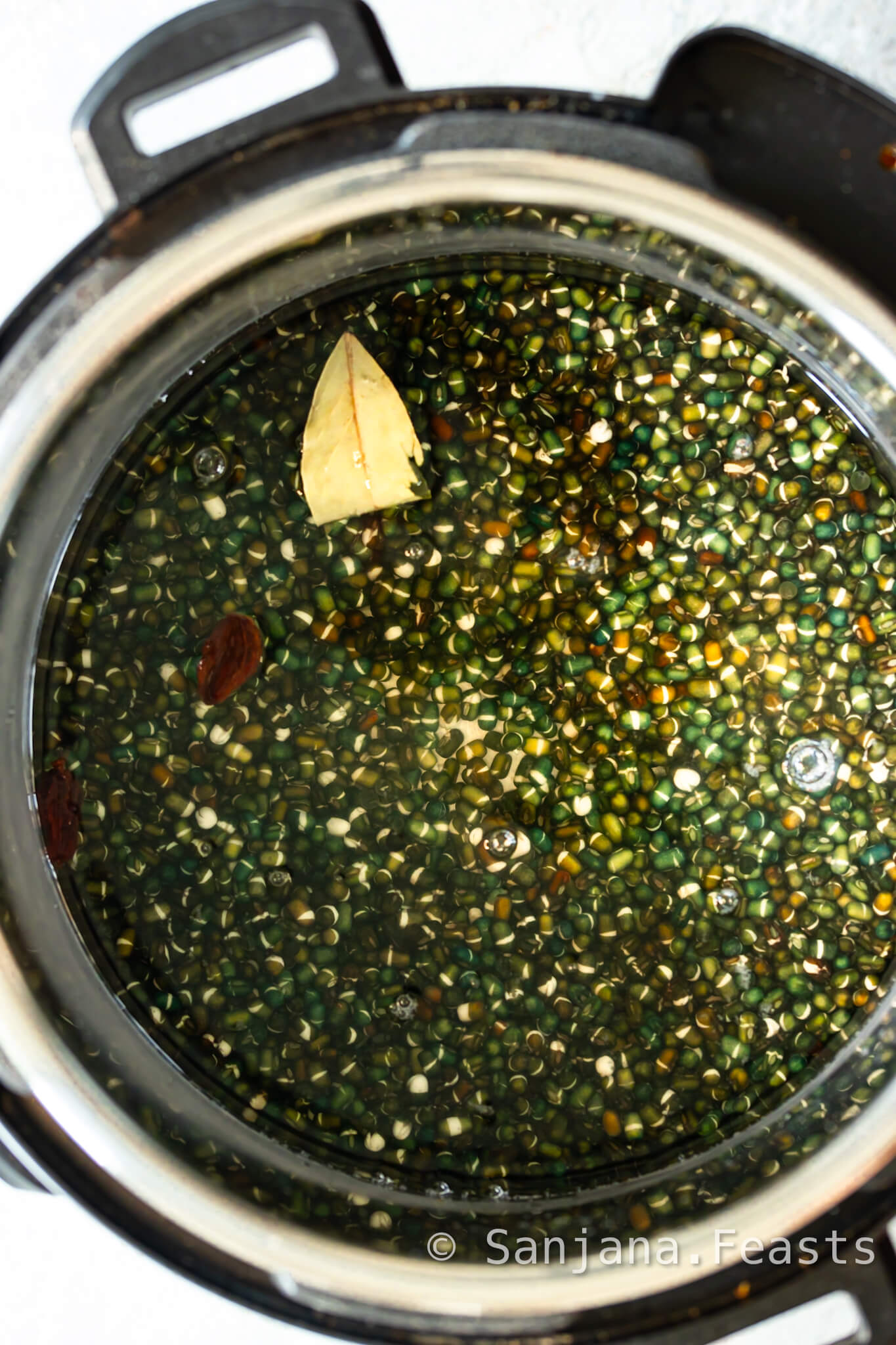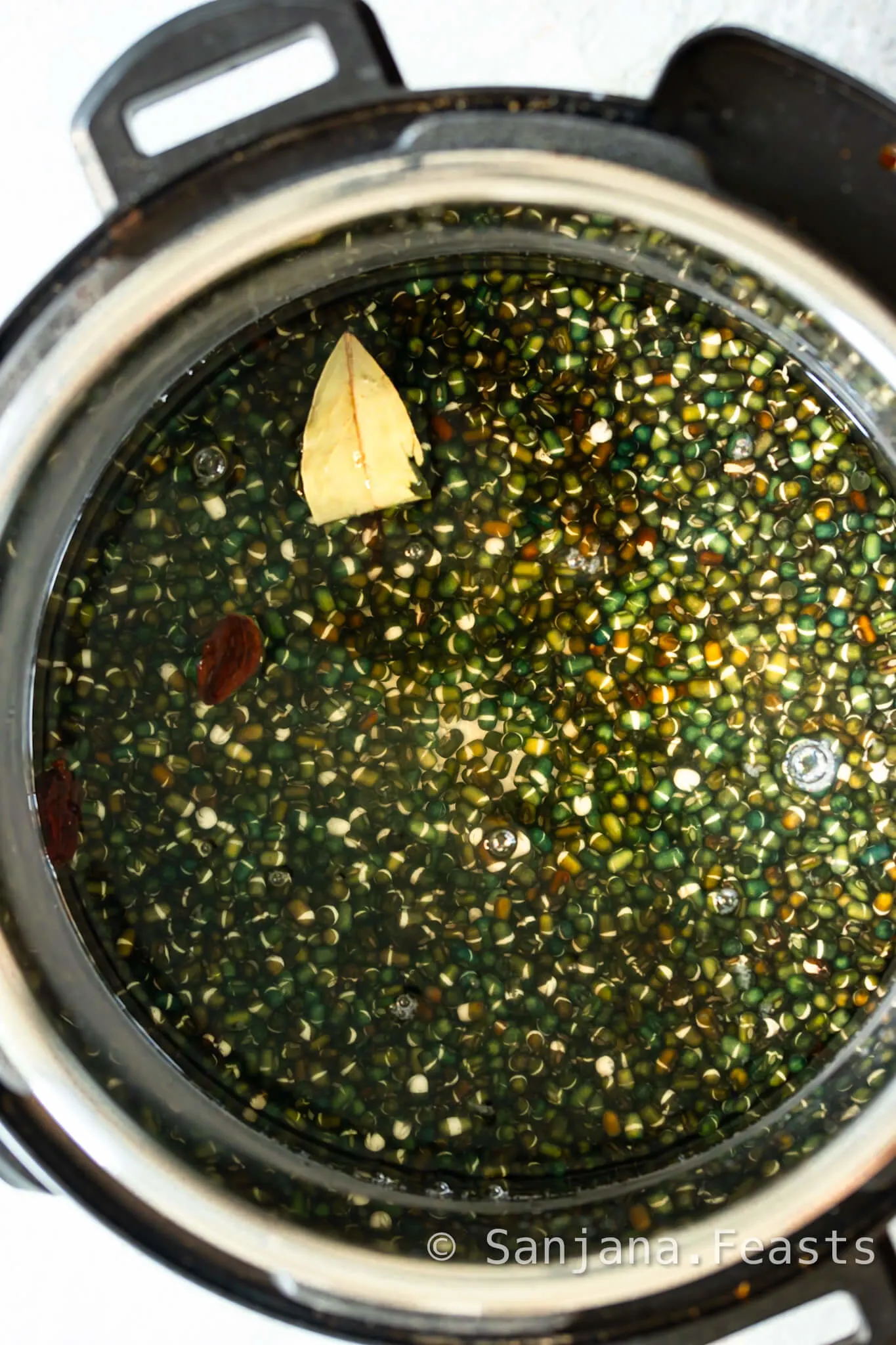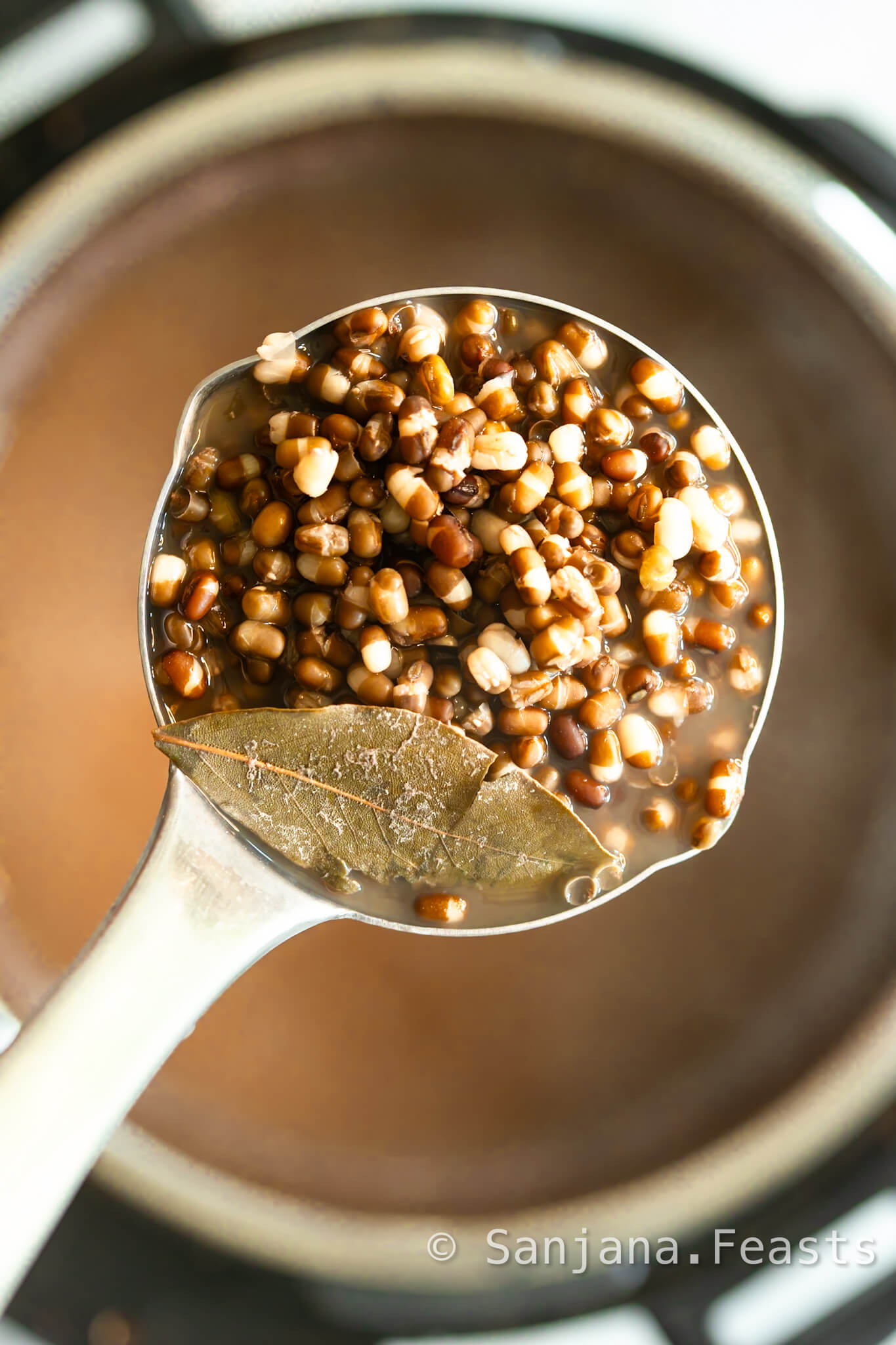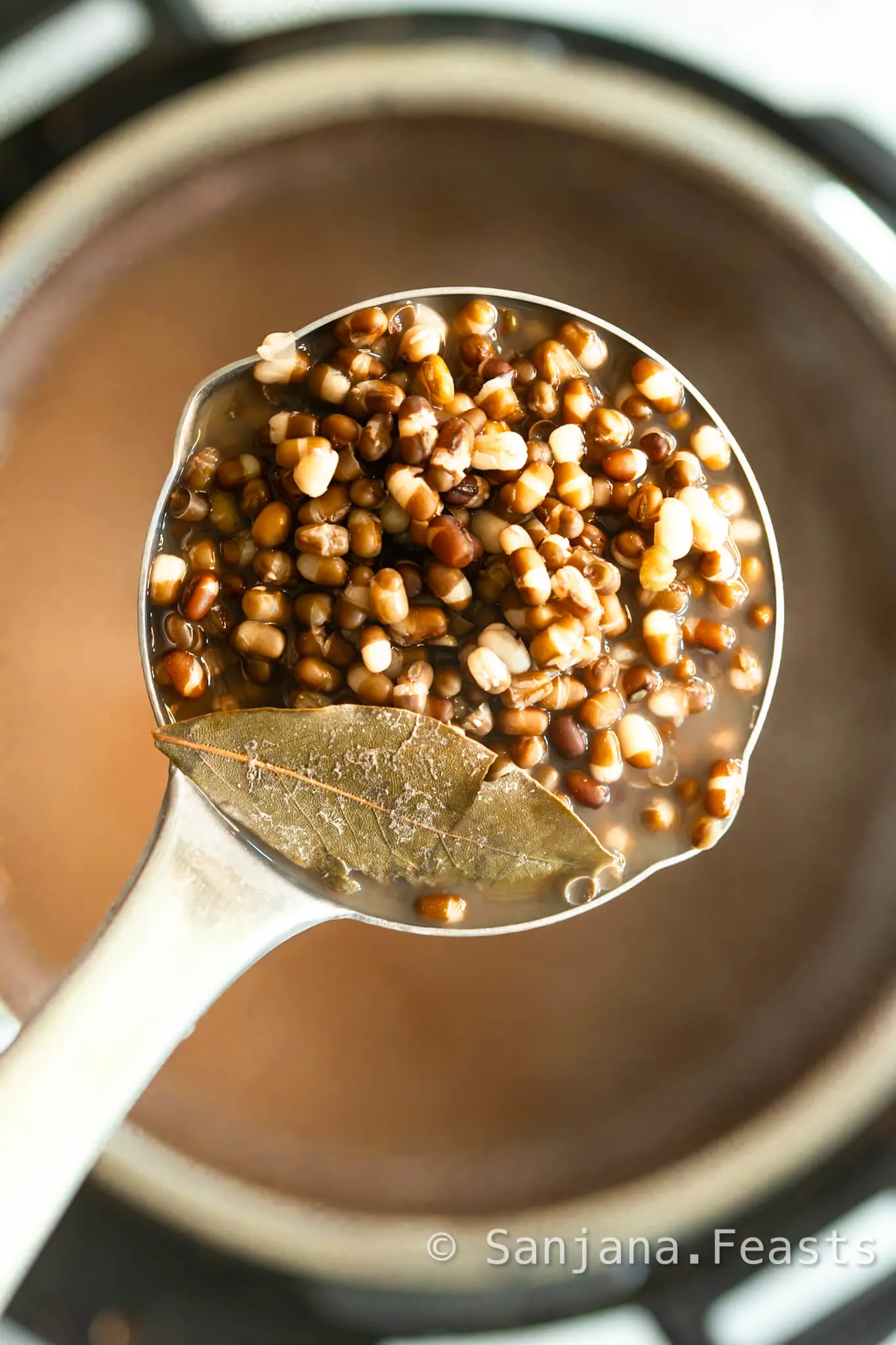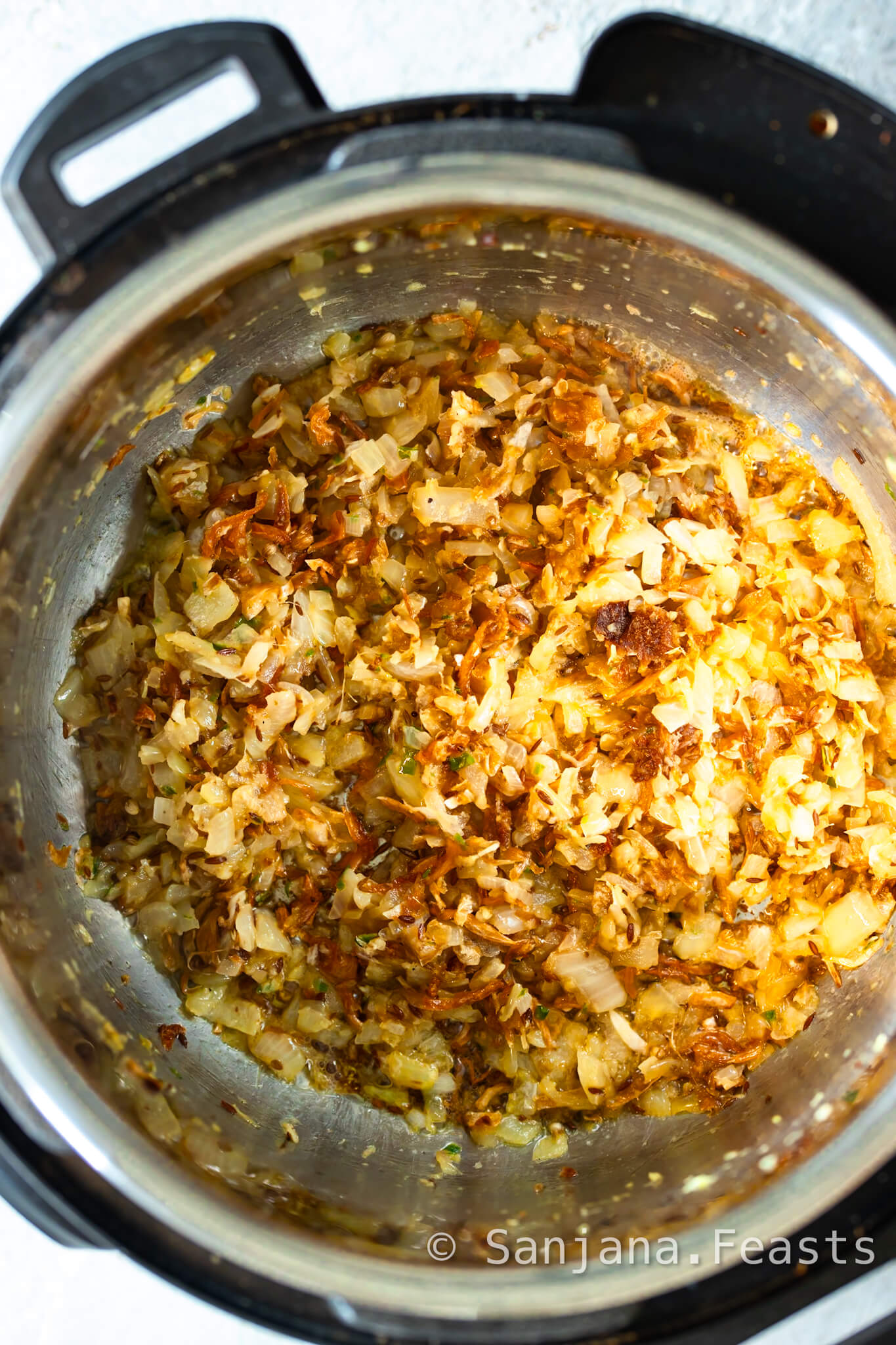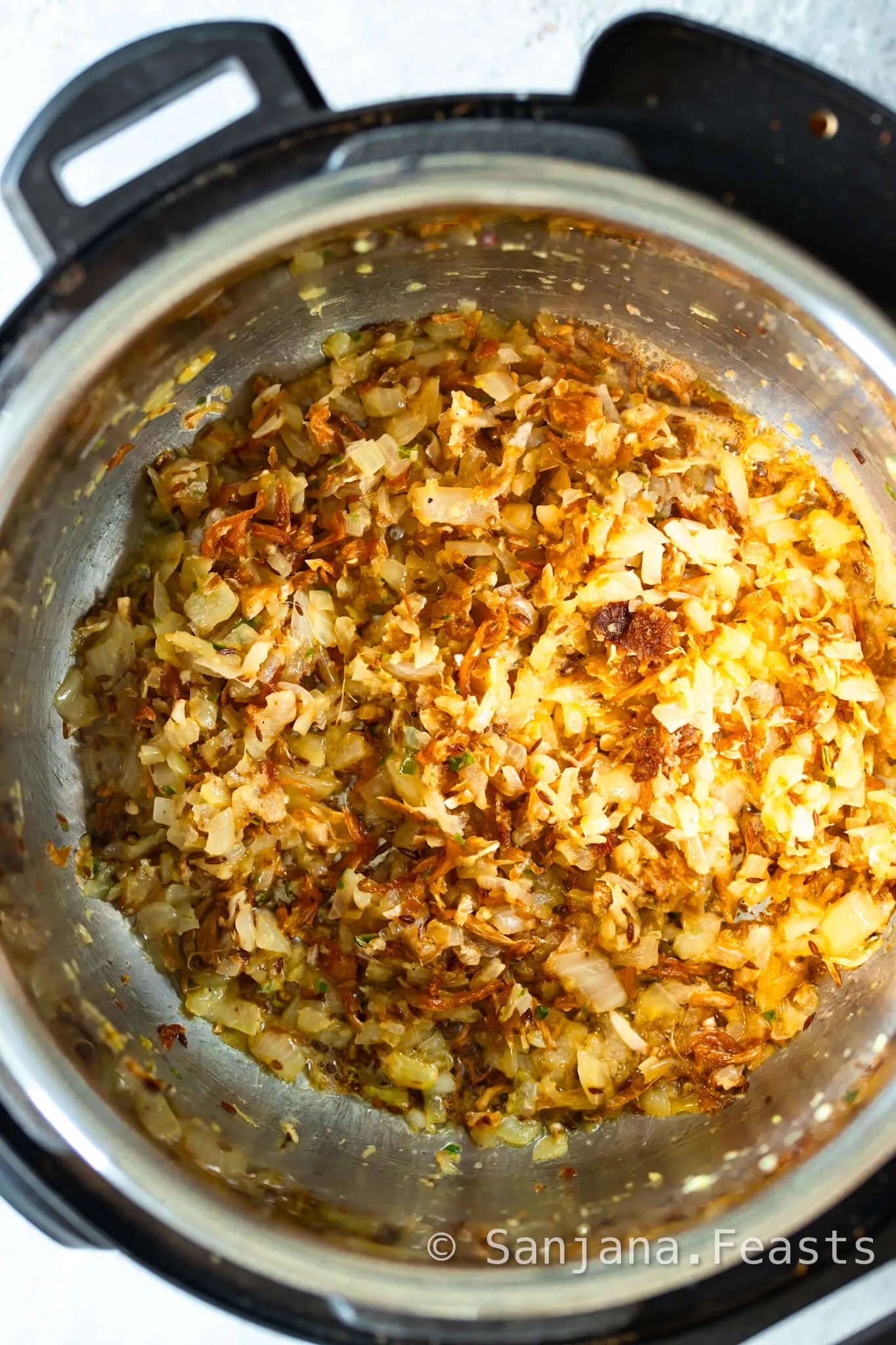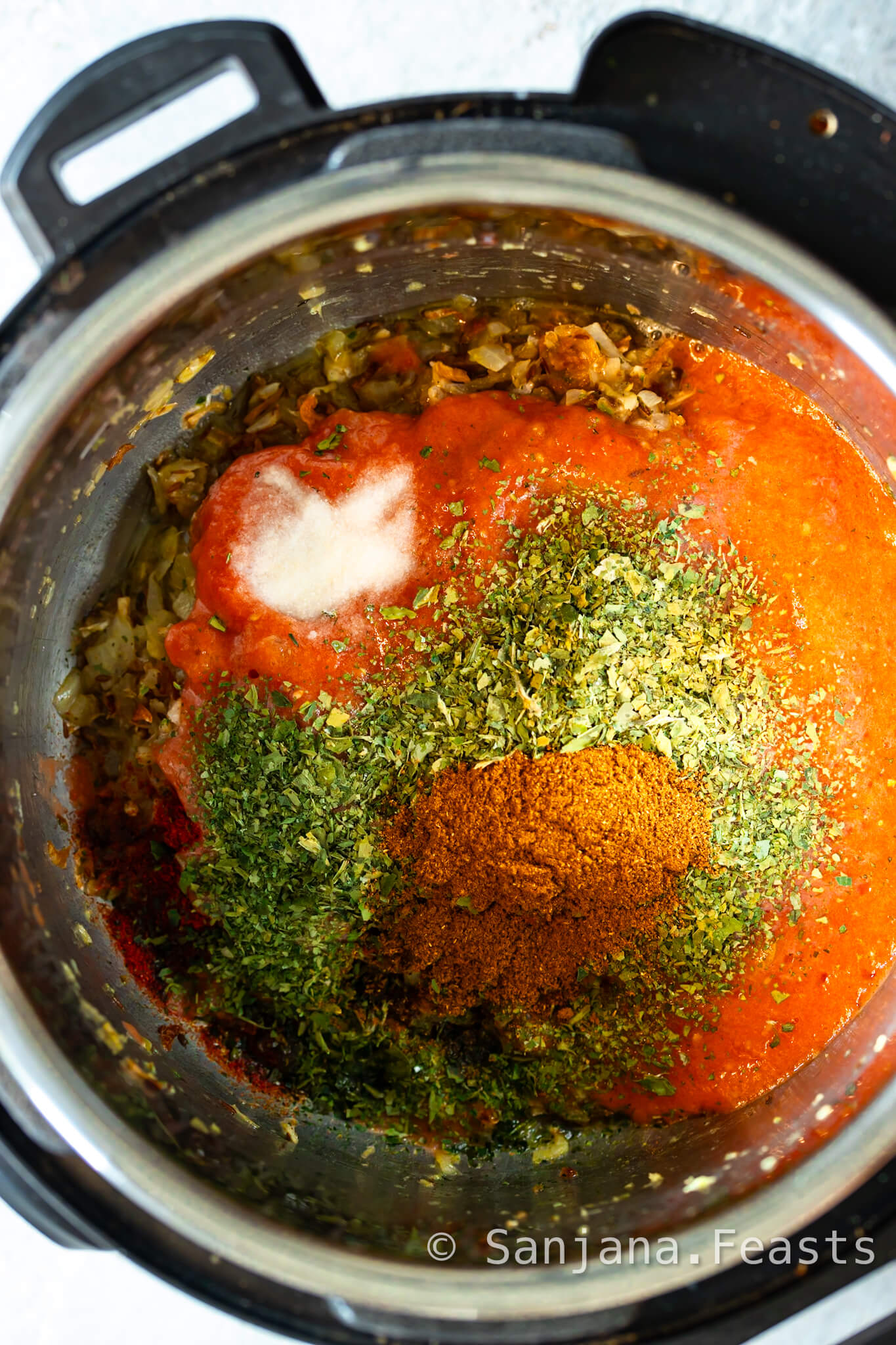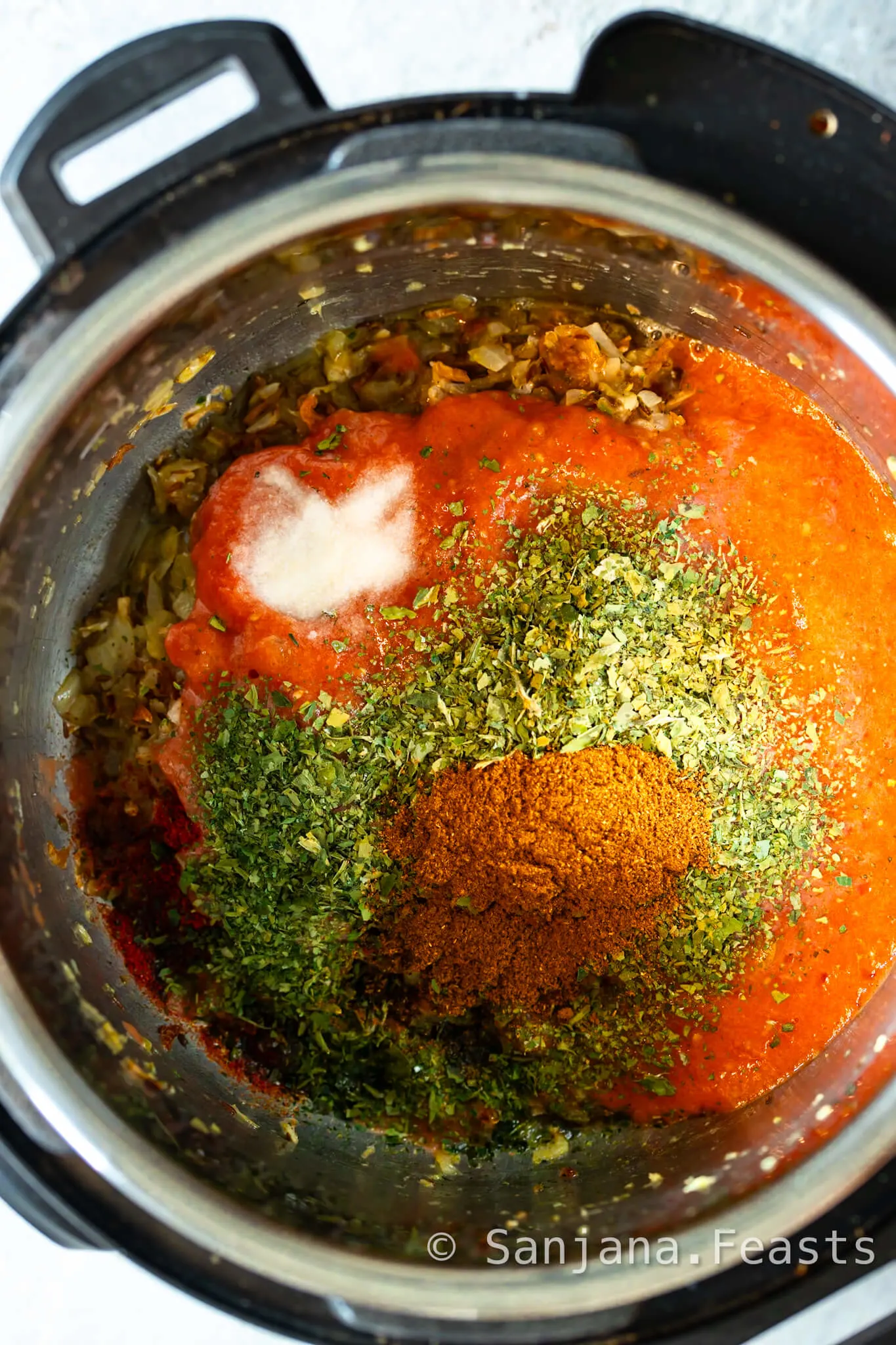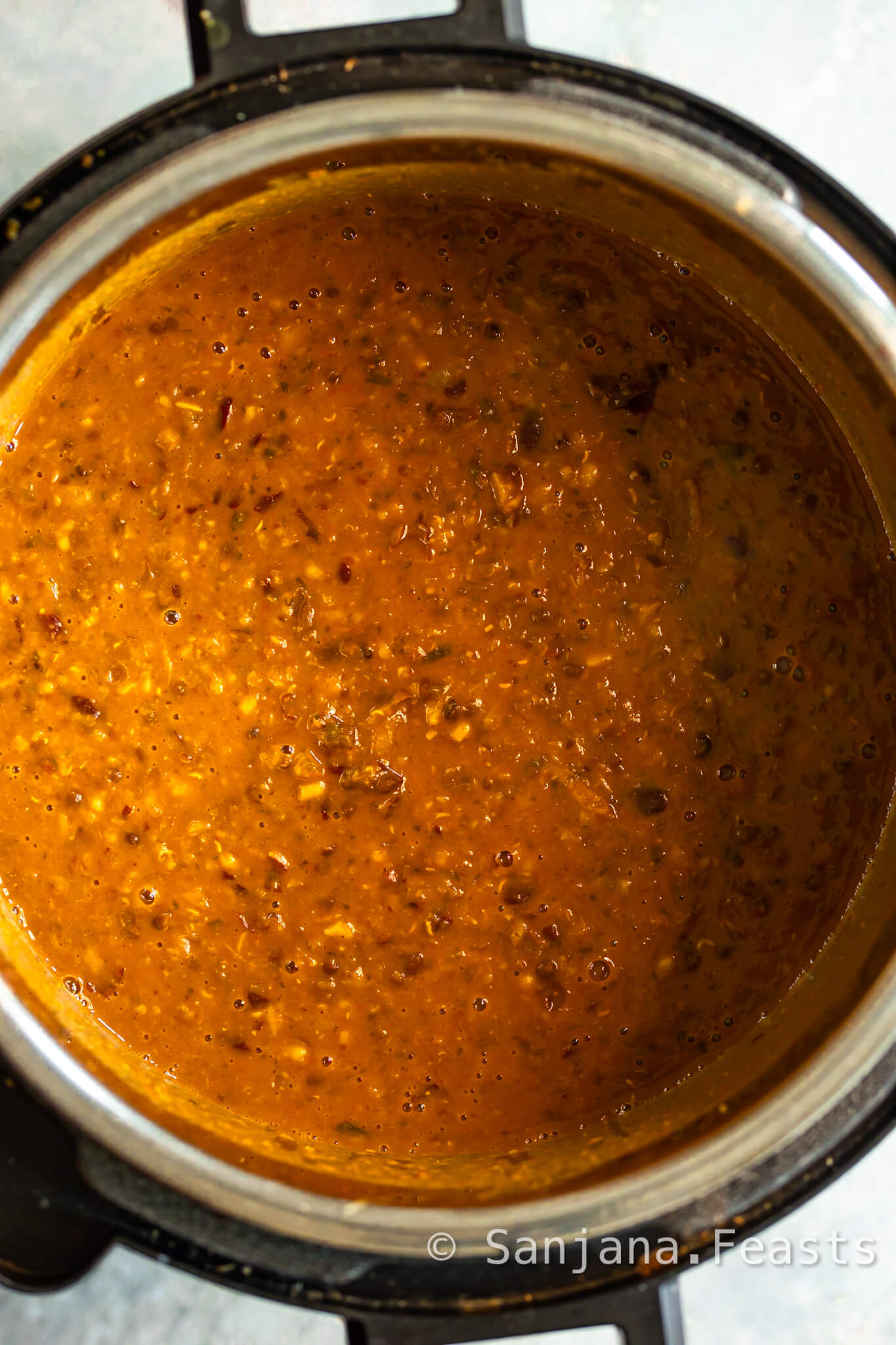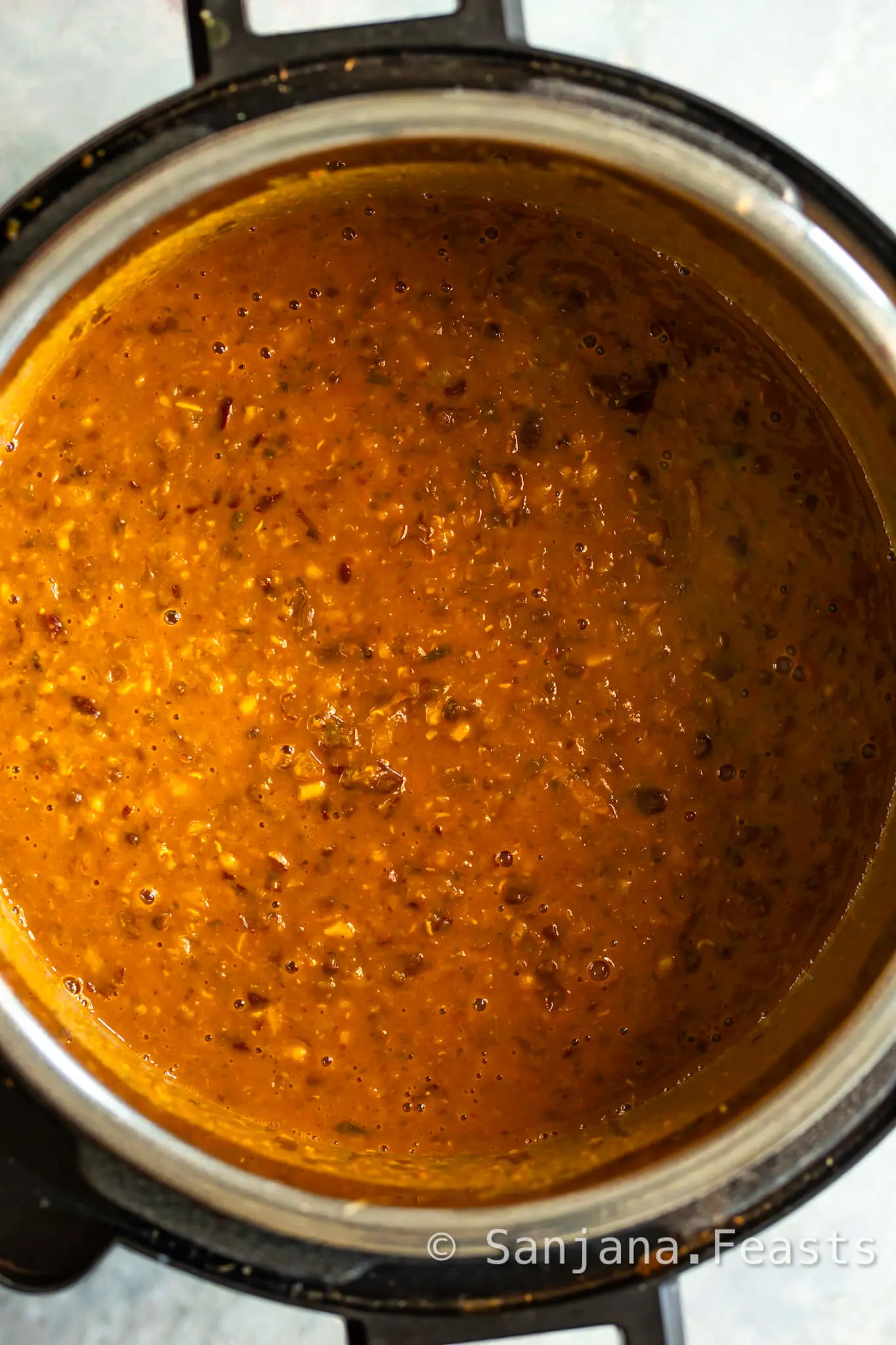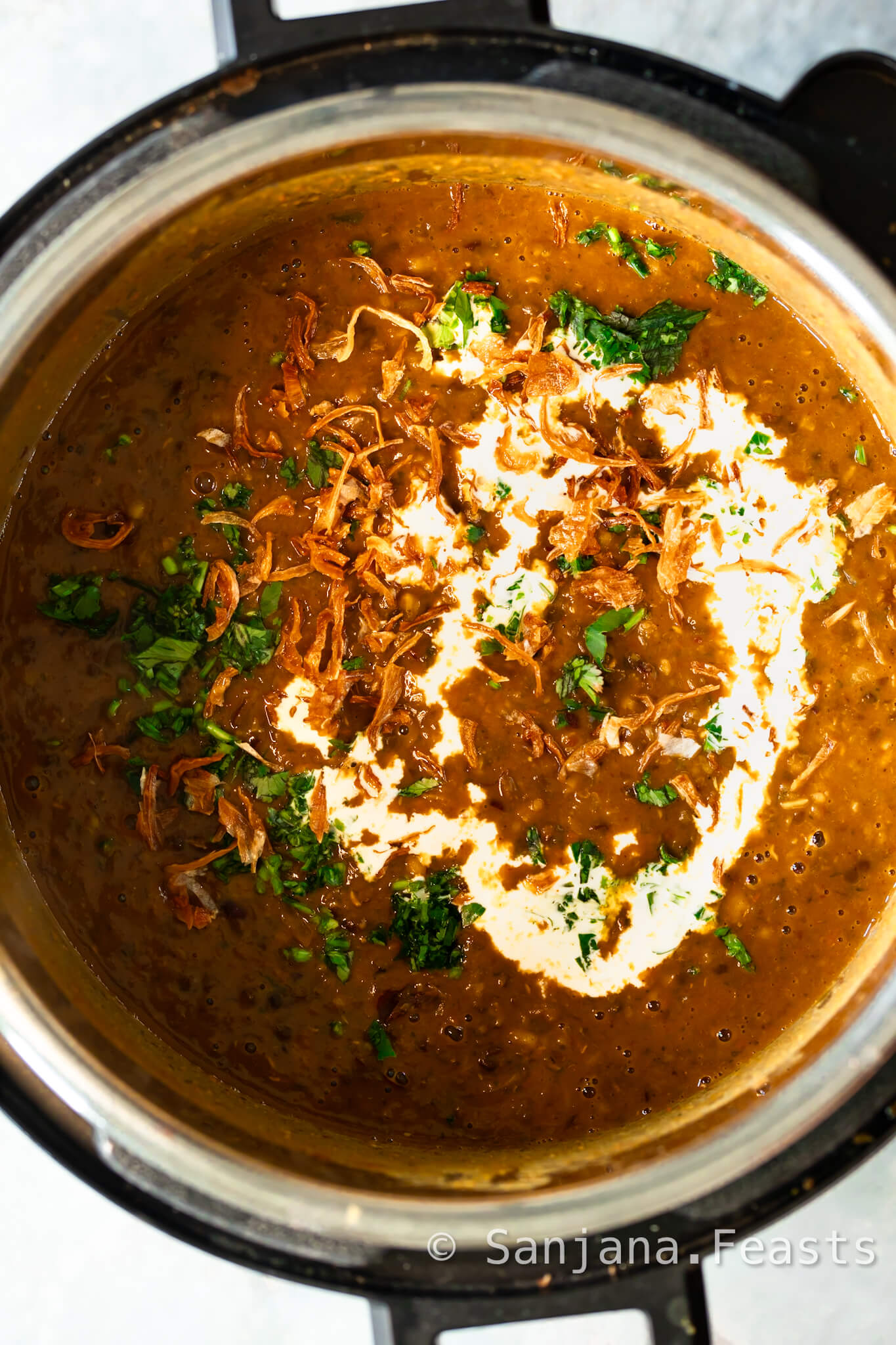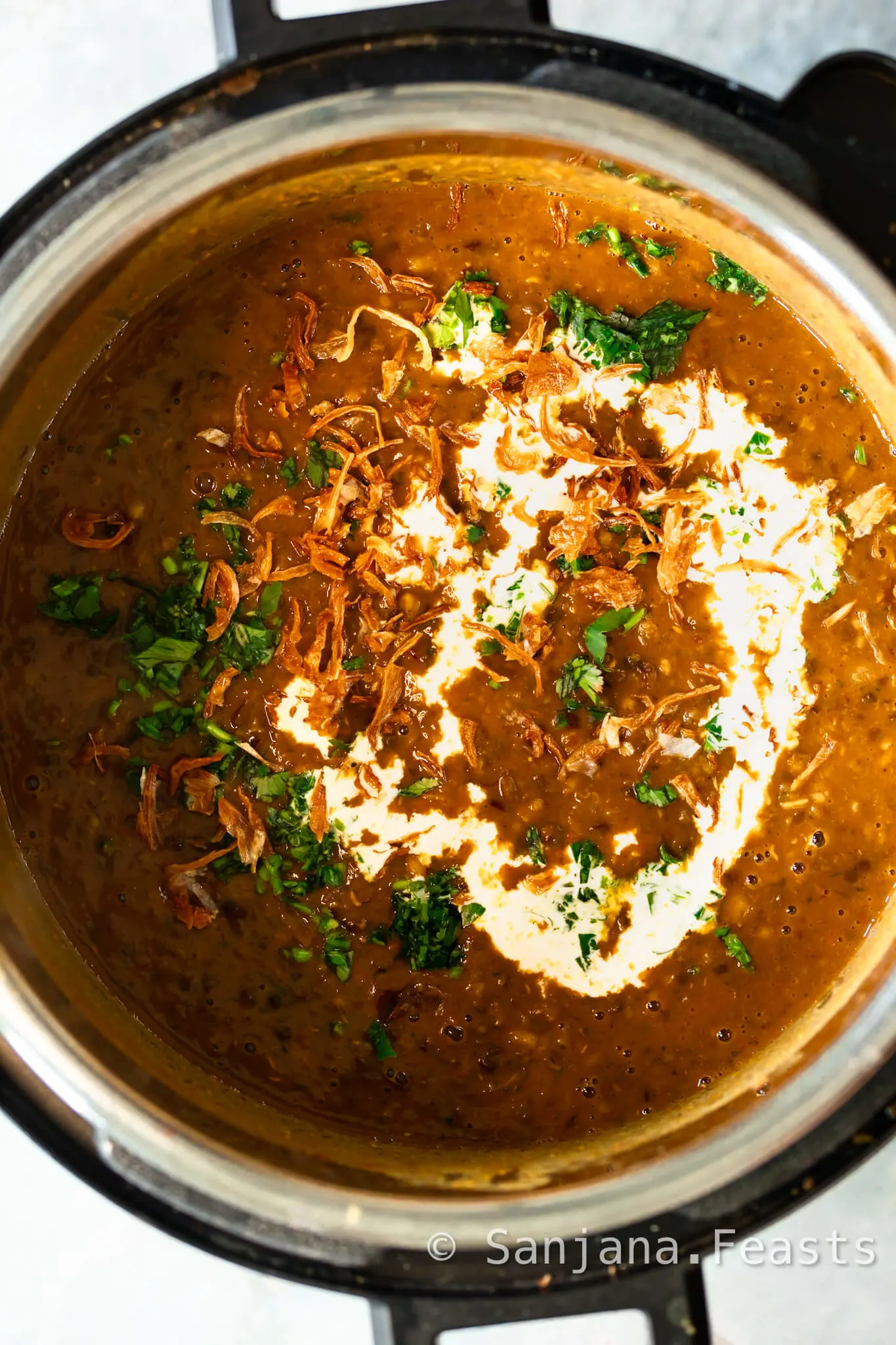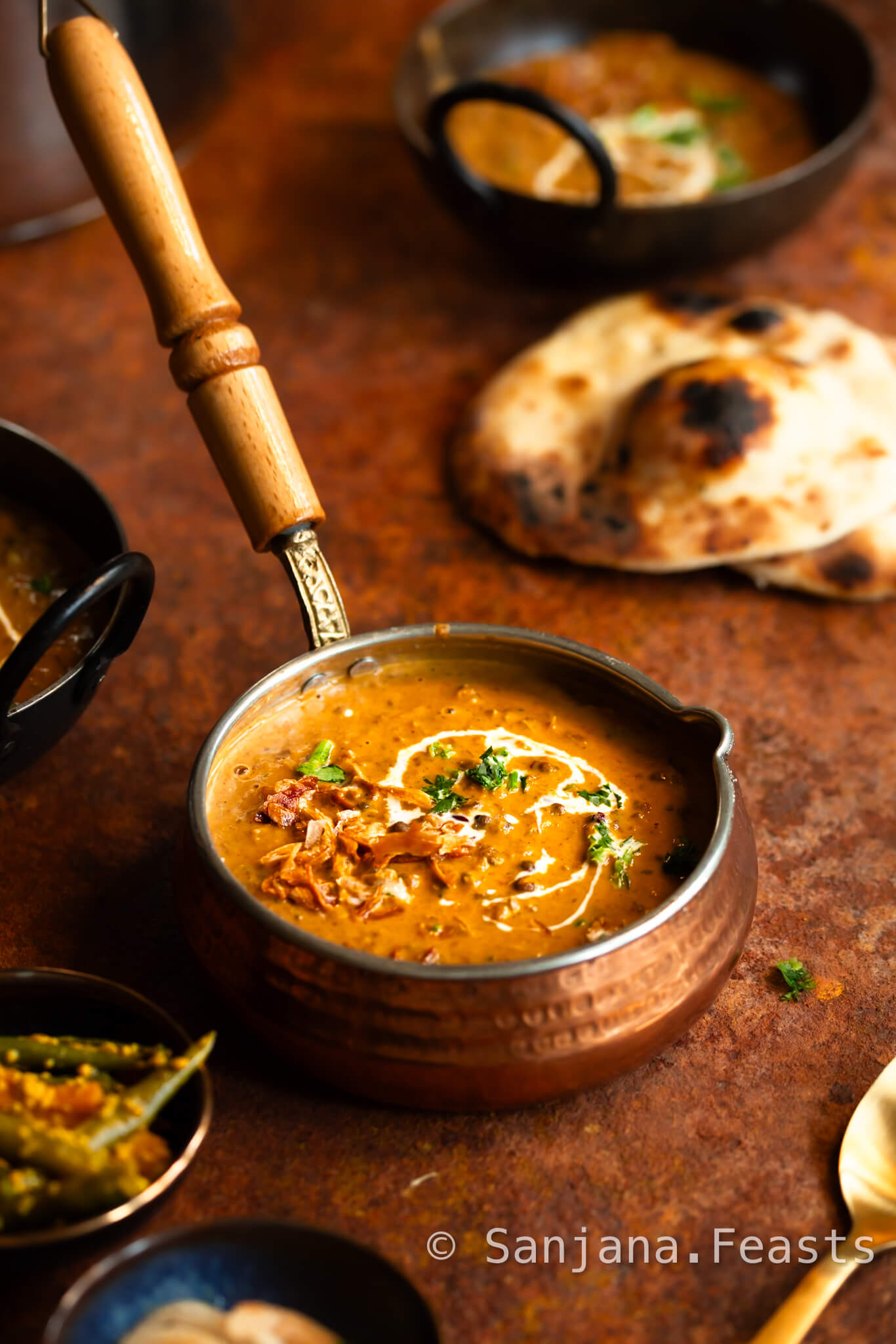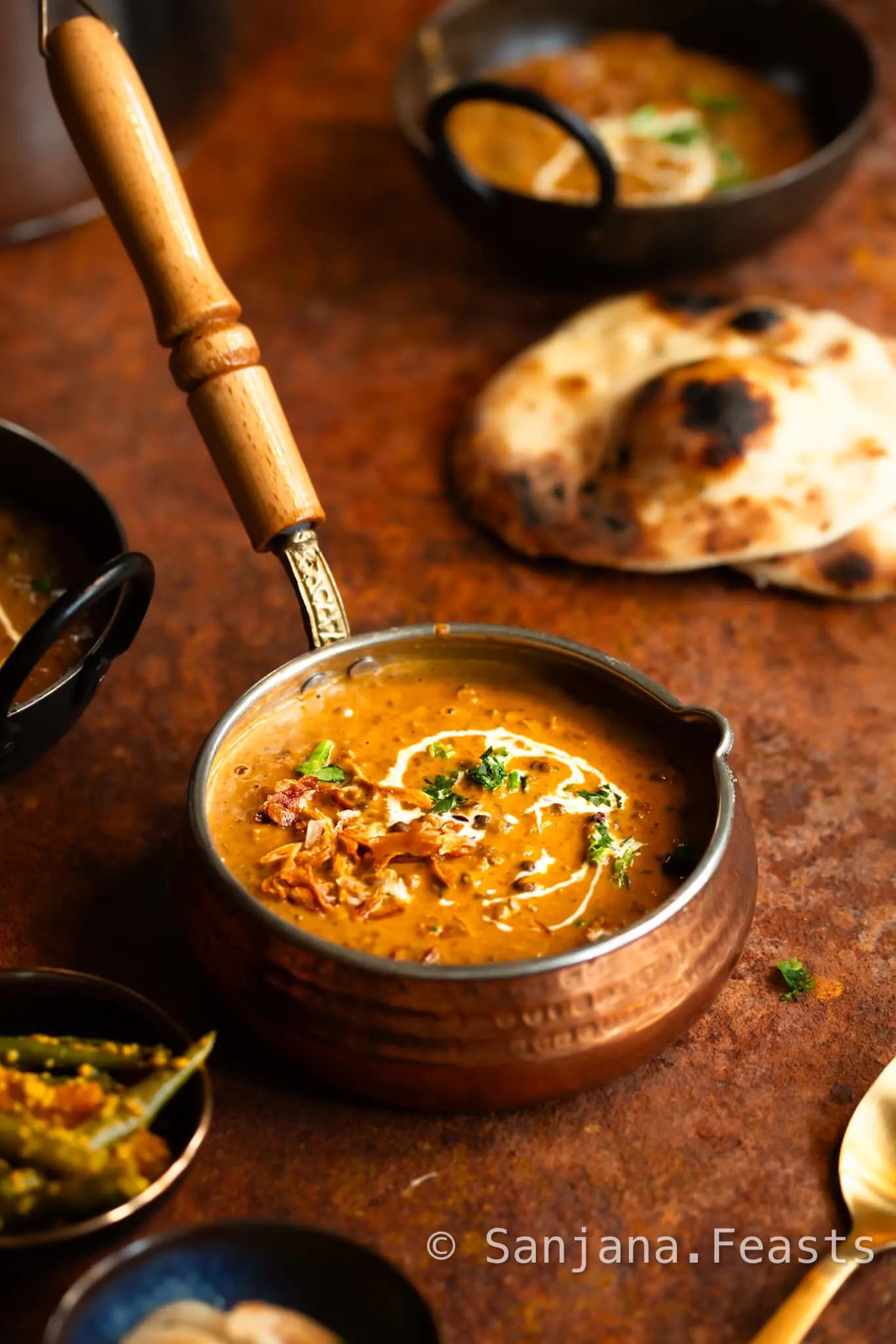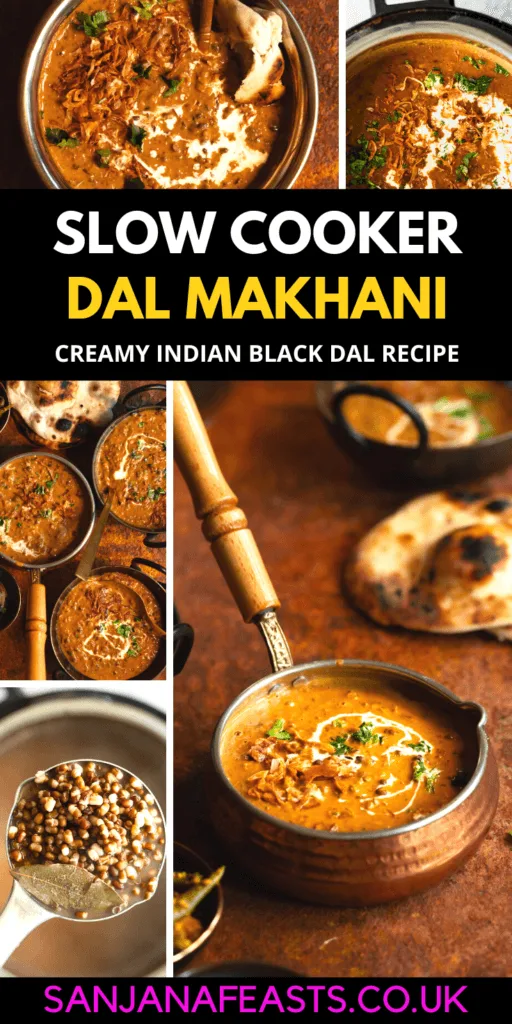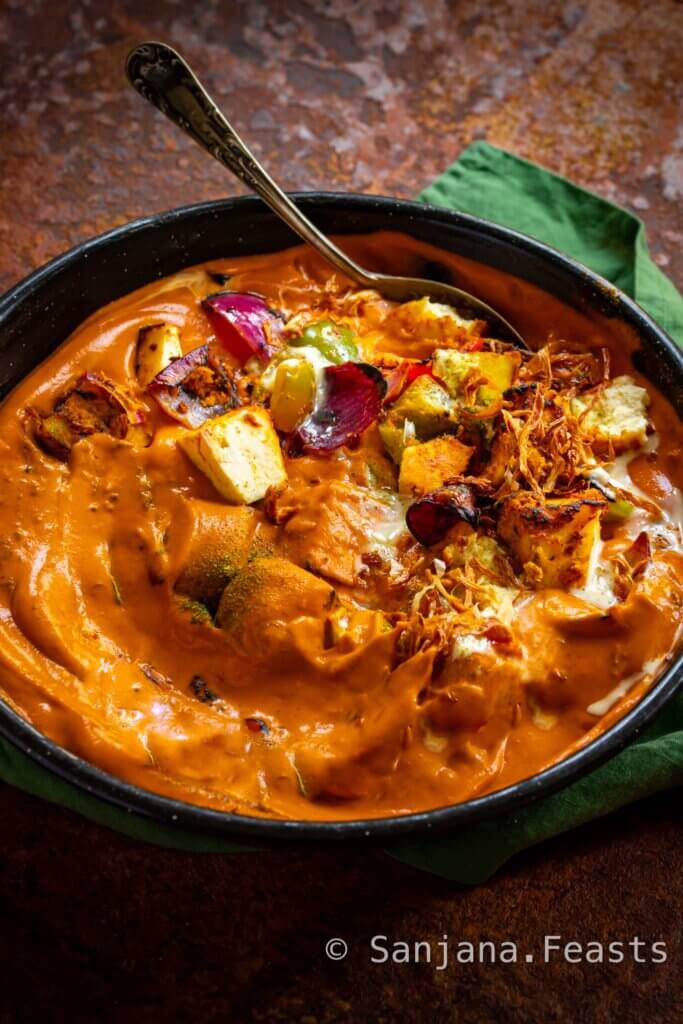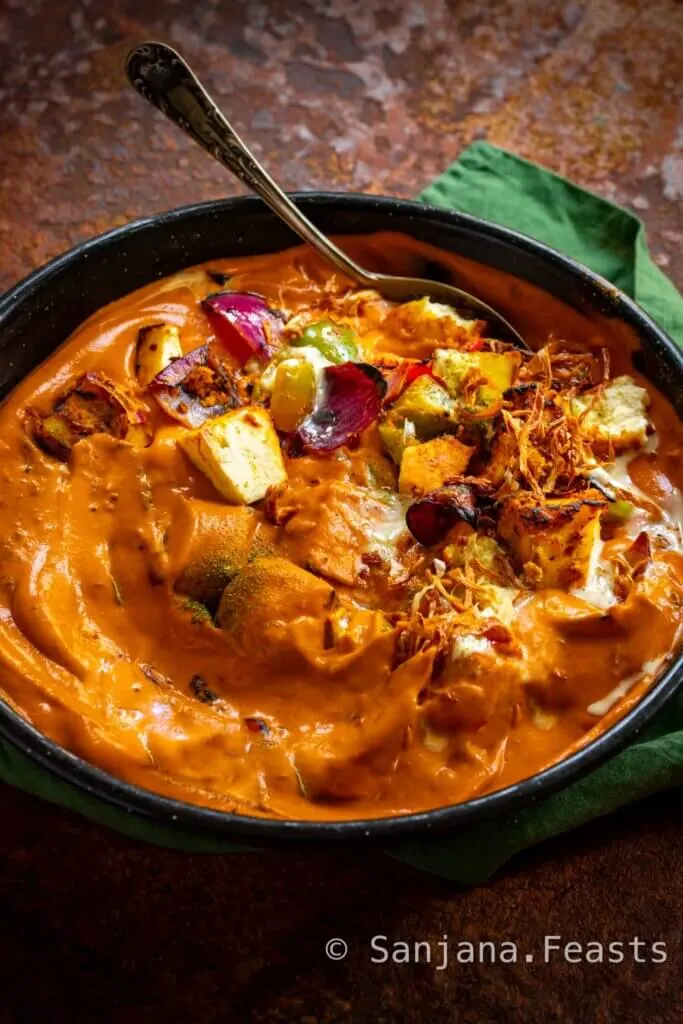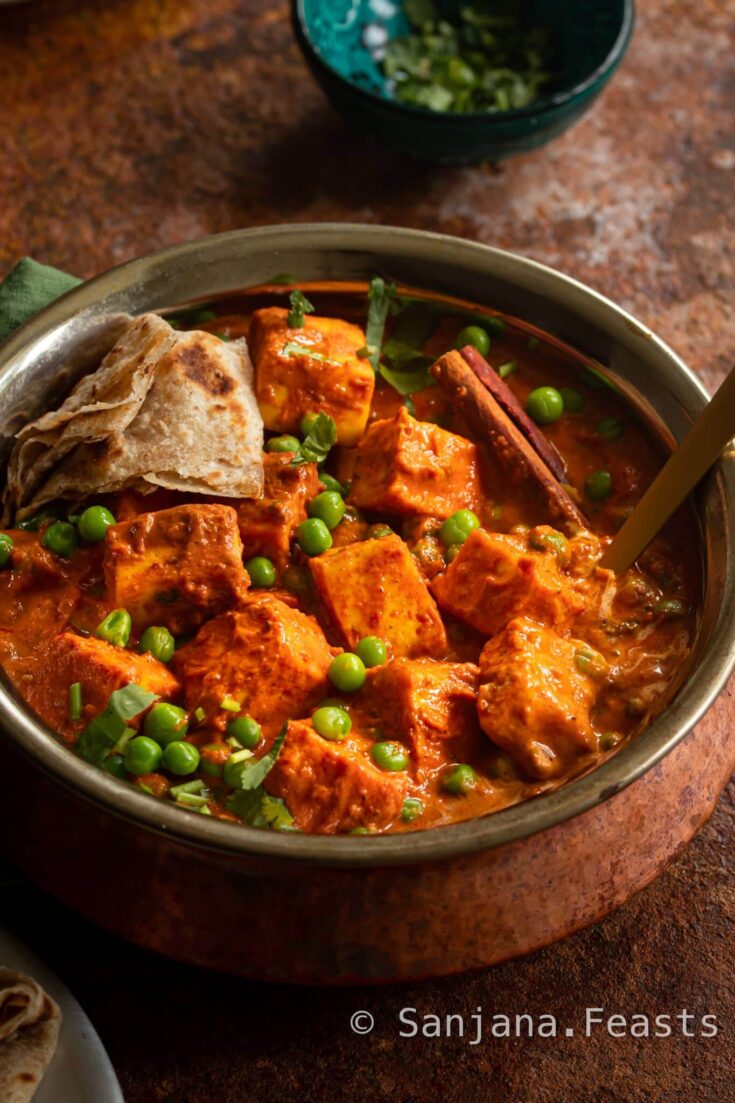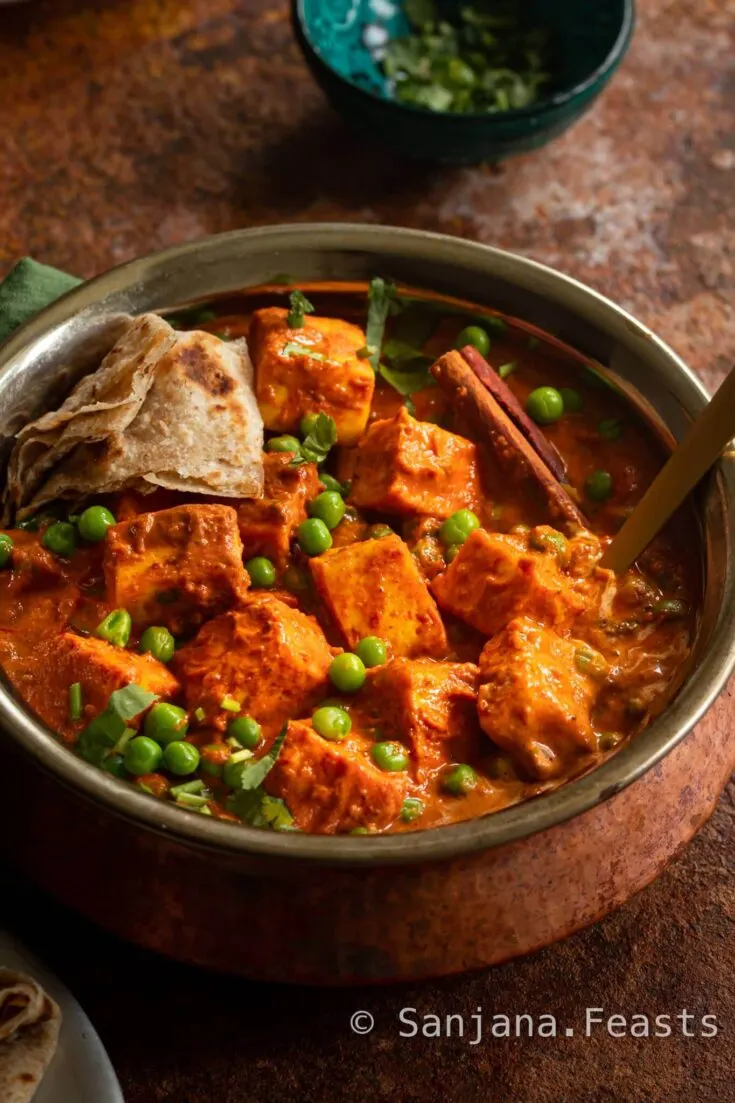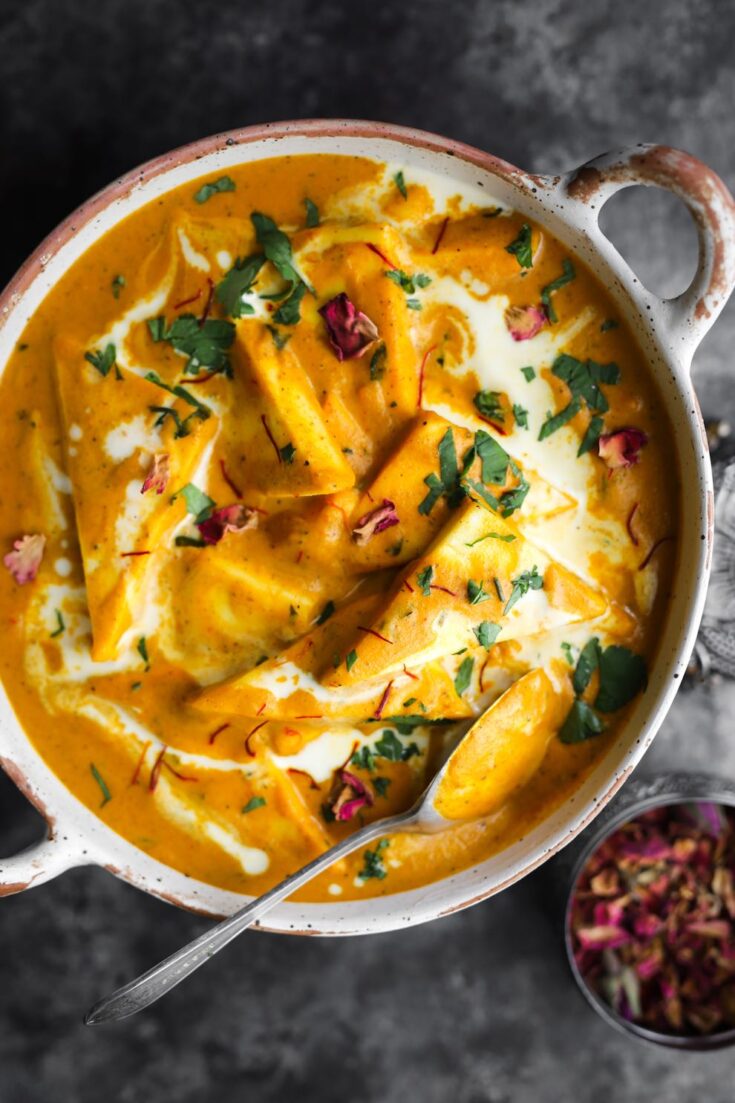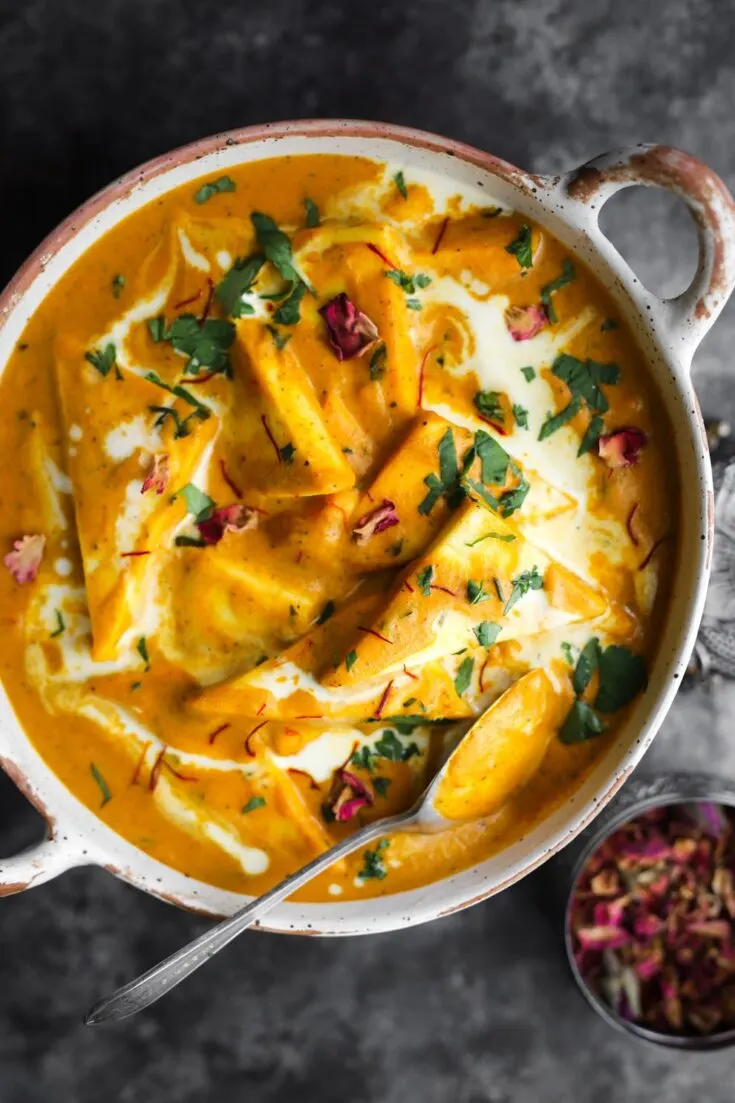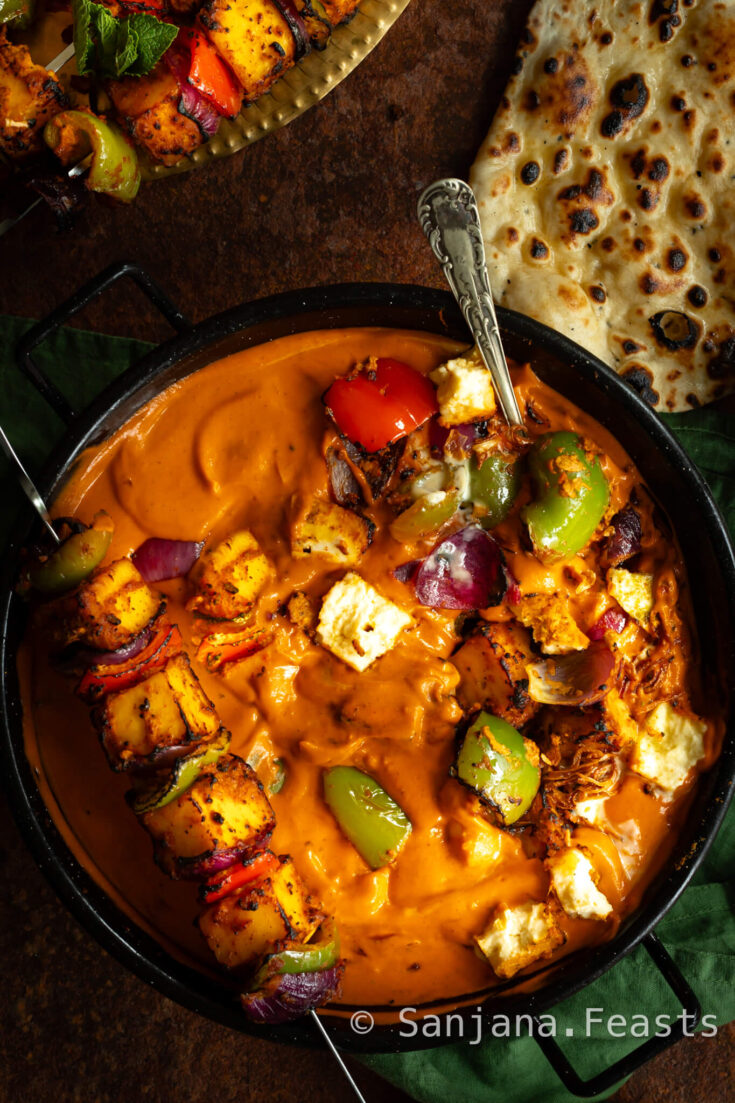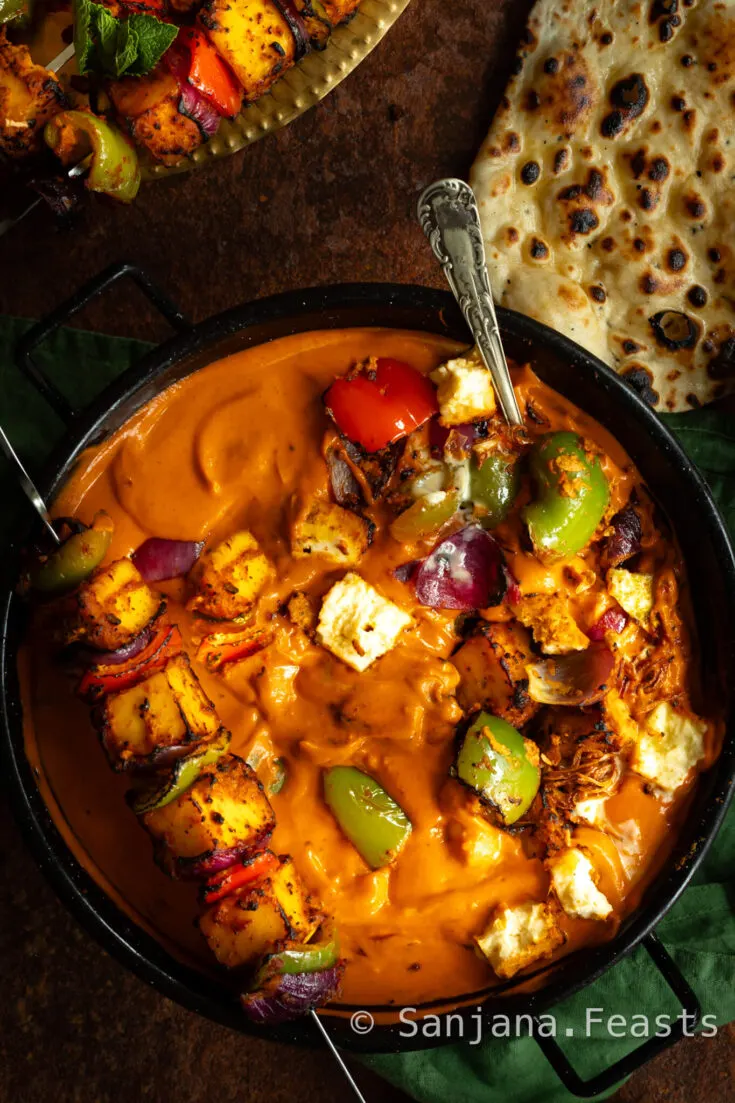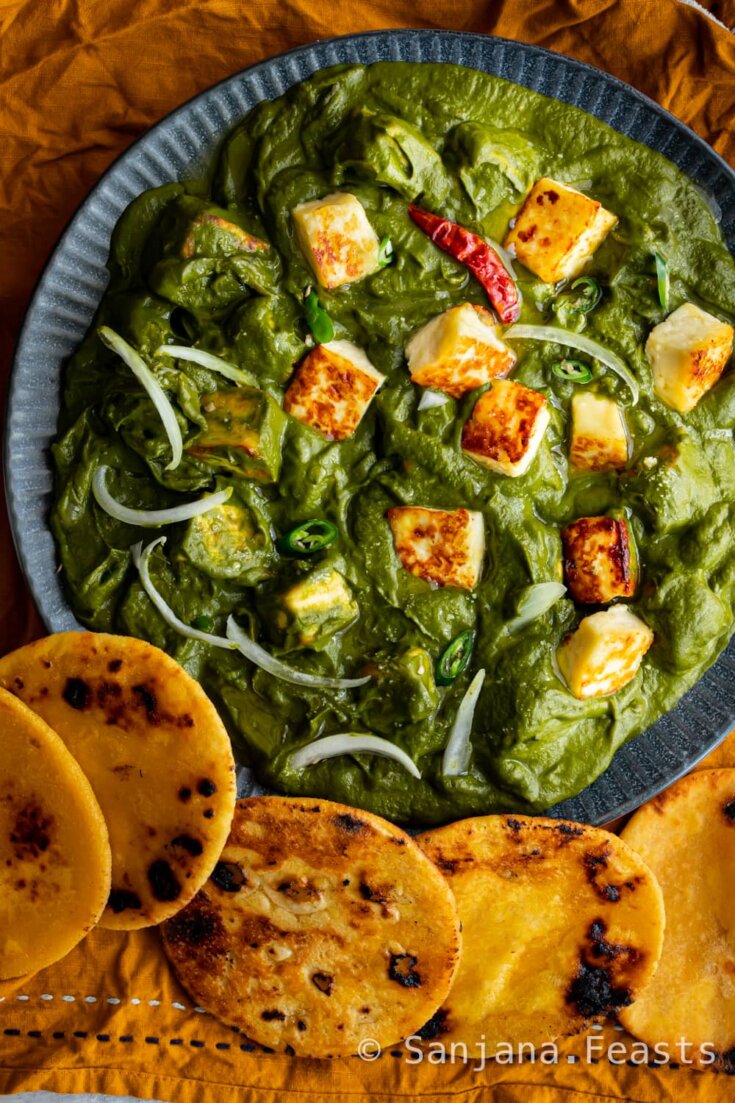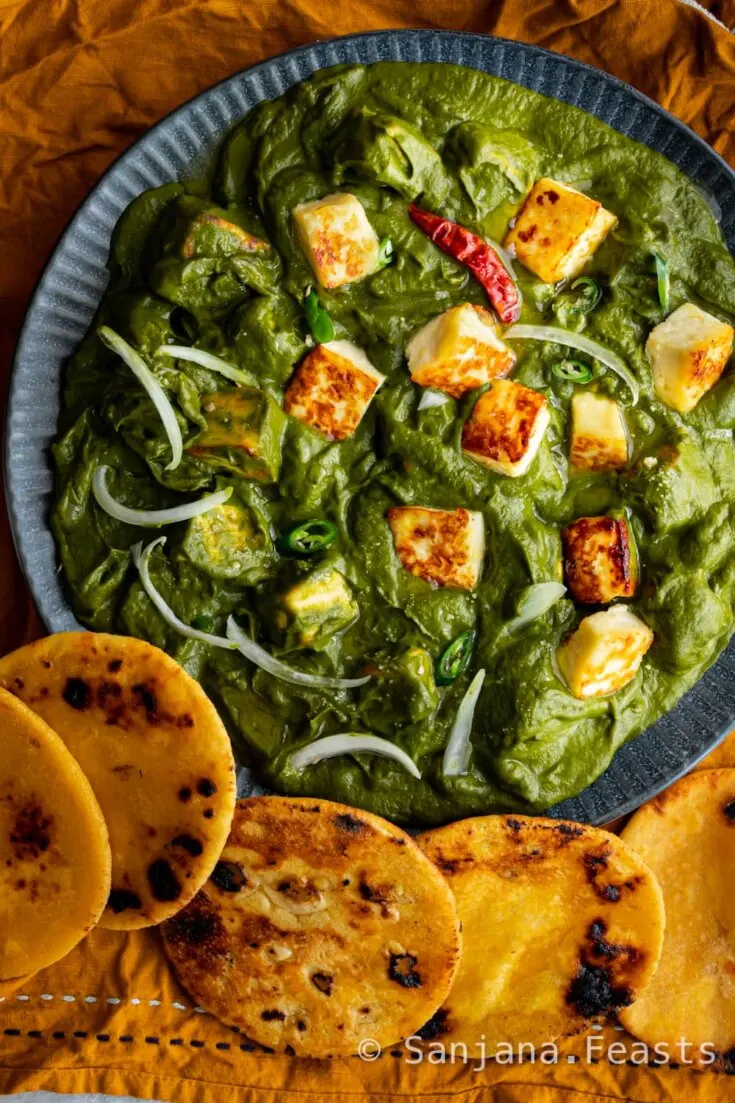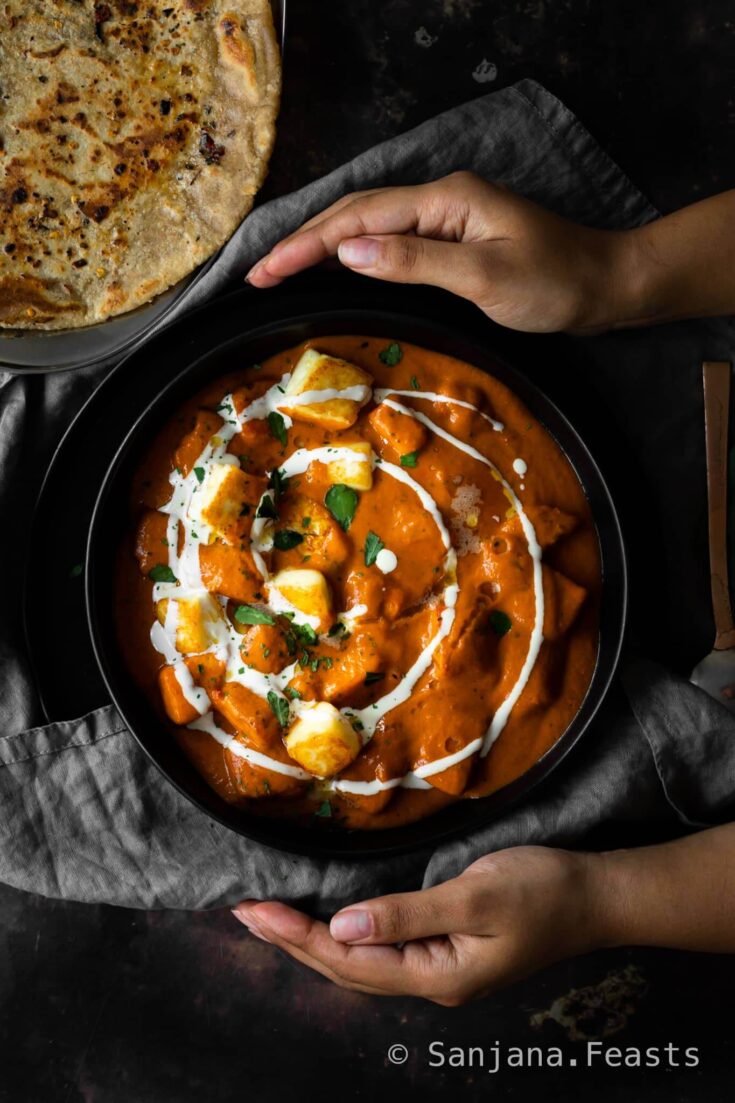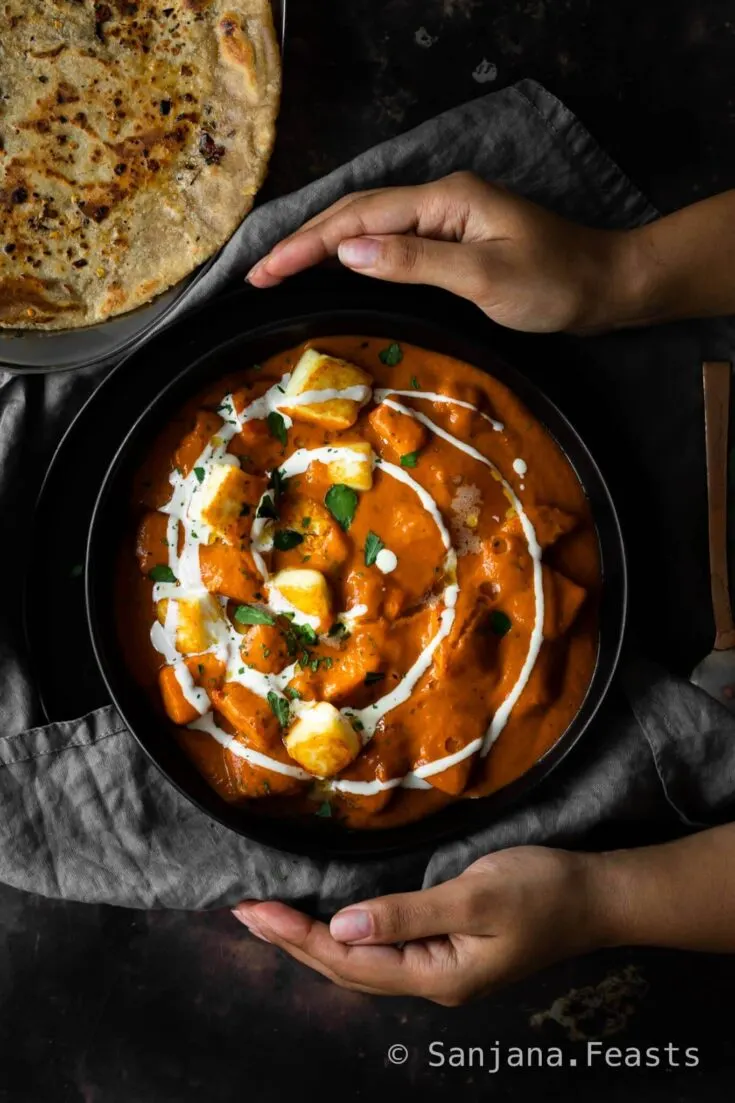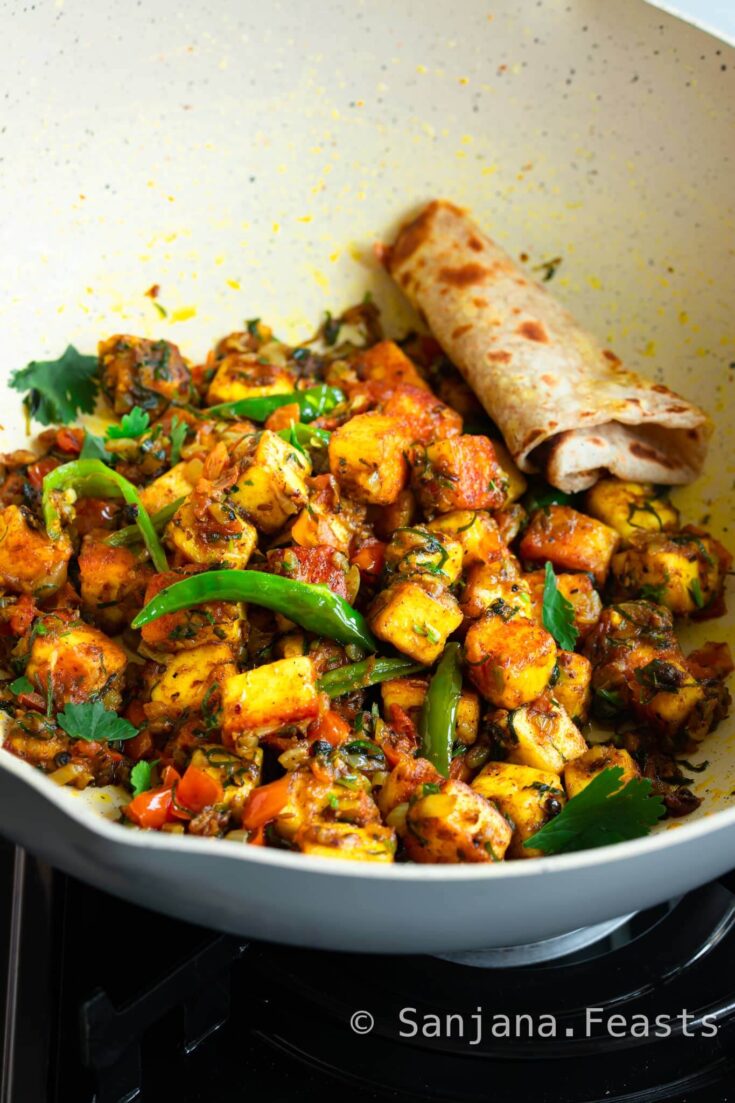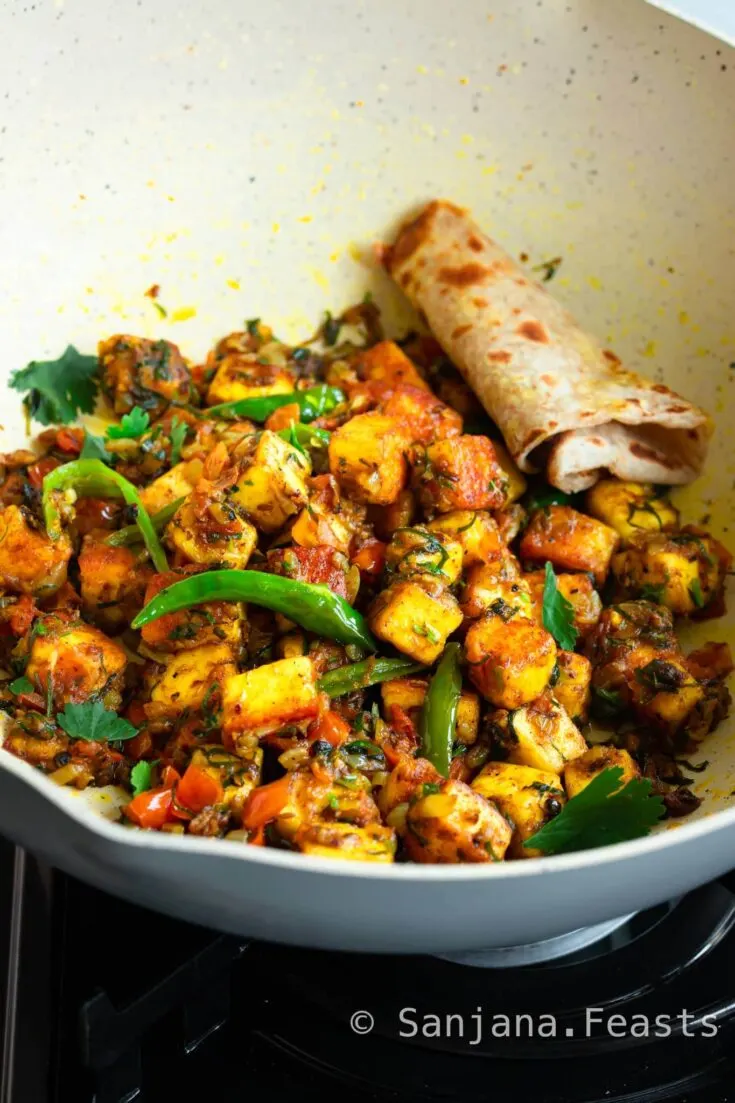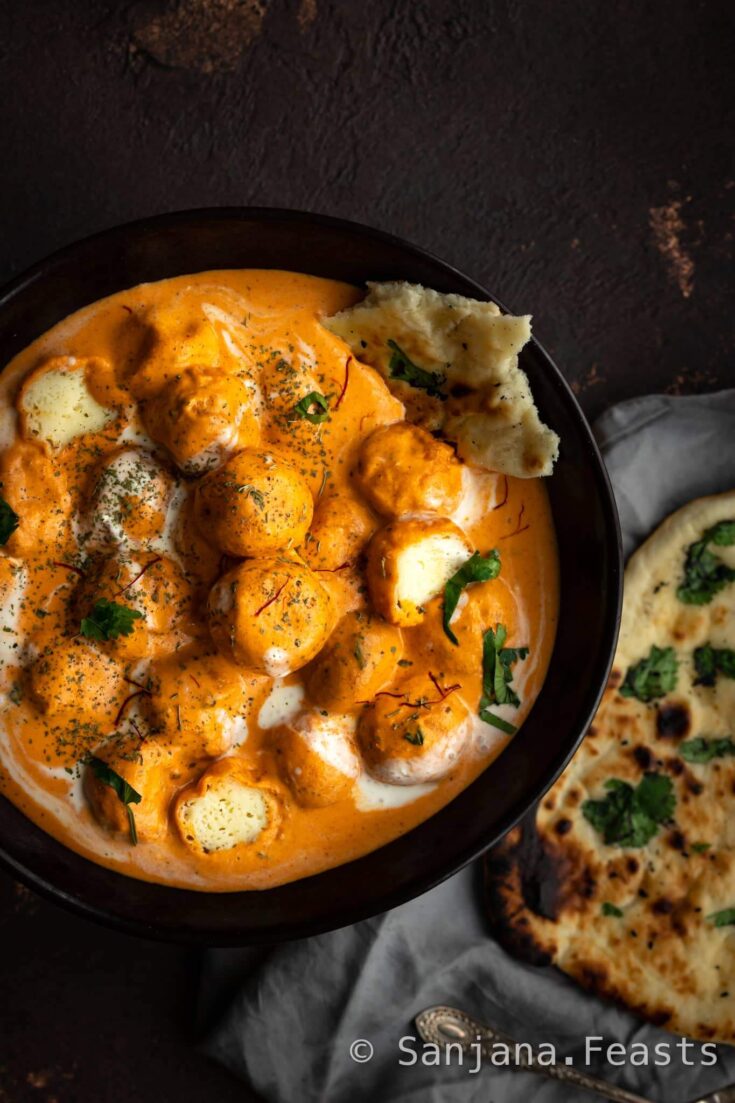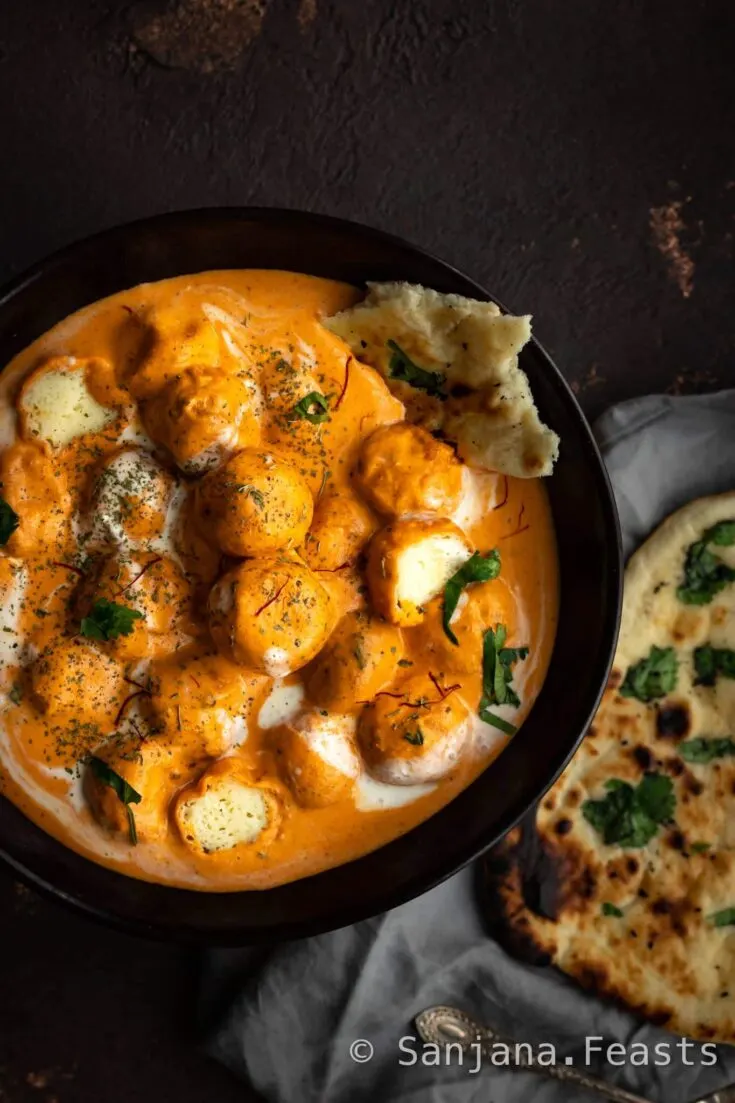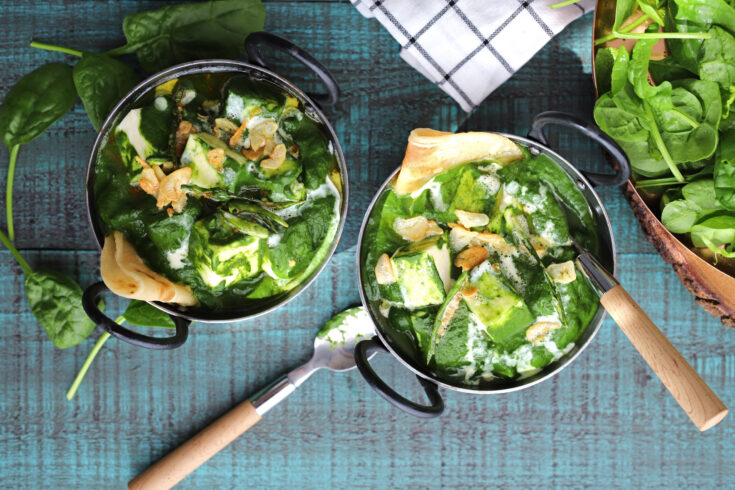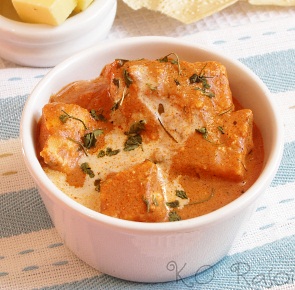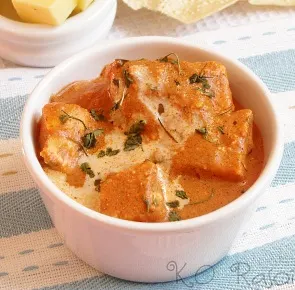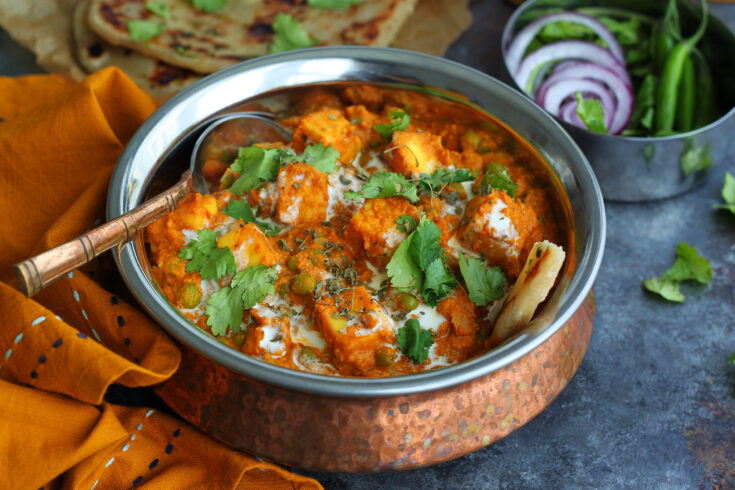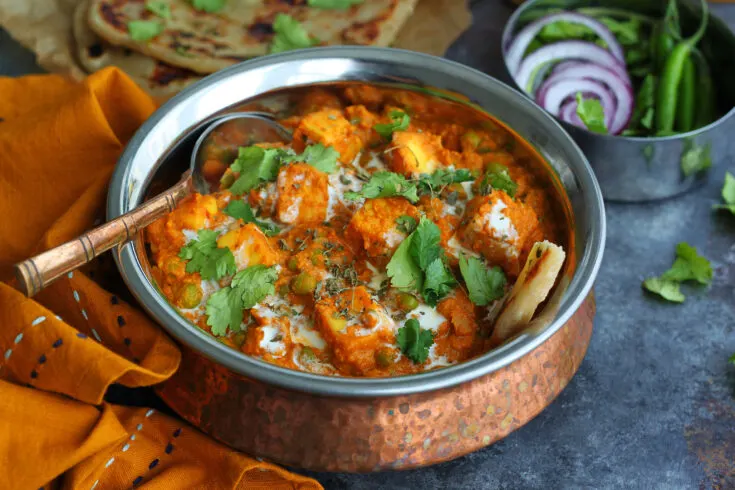Dal Makhani, or Black dal is an Indian lentil dish with black gram (urad) with butter, spices and cream. It’s rich, smoky and has bags of flavour. Remember that the rich, complex flavours of Dal Makhani develop as it cooks. The longer it simmers over a low heat, the tastier it will be. You may also know this dish as Dal Bukhara, a dish created in North India’s famous Moti Mahal which was also the birthplace of Butter Chicken (Murgh Makhani).
This recipe for Dal Makhani is…
Rich and delicious restaurant-style recipe Vegetarian Gluten free Nut and soy free A good source of plant-based protein
What is Dal Makhani?
Spicy black lentils and kidney beans simmered with butter, onions and spices until luxuriously thick and creamy. This Indian dal has North Indian roots and is delicately smoky as its typically simmered over warm coals for hours. As the urad lentils cook, they release starch, which rather helpfully thickens the dal and makes it perfect for scooping up with naan and roti.
Which dal is Dal Makhni made of?
For Dal Makhani you will need whole or split black gram, also known as urad. It’s a small, black bean native to South Asia. Urad is a nutritional powerhouse packed with protein, fiber, and other essential nutrients. They’re available whole or split with their skins on or off. The white (husked) variety of urad is commonly used for making Dosa.
What do you eat with Dal Makhani?
When it comes to pairing with the delicious richness of Dal Makhani, you have a variety of options! Here are some choices…
Breads
Naan: Fluffy and pillowy naan, especially garlic naan, is a classic pairing for scooping up the flavourful dal. Roti: A lighter flatbread like roti is another great option, offering a slightly chewy contrast to the smooth dal. Tandoori Roti: Tandoori-cooked roti adds a smoky touch that complements the smoky notes in the dal. Paratha: Flaky and layered parathas, like aloo paratha with potato filling, can add another dimension of texture and flavour.
Rice
Basmati Rice: Plain basmati rice is a perfect canvas for the dal’s flavours to shine. Jeera Rice: Infused with cumin seeds, jeera rice adds a warm and earthy touch to the meal.
Other sides
Raita: A cooling yoghurt-based condiment with cucumber or other vegetables can help balance the richness of the dal. Salad: A simple salad with fresh greens and a light dressing offers a refreshing contrast. Pickles: Indian pickles add a tangy and spicy element to the meal.
Ultimately, the best accompaniment for Dal Makhani depends on your personal preferences! It’s also common to enjoy it simply with rice or bread, letting the dal be the star of the show.
Here are some additional tips…
Consider the richness of your Dal Makhani. If it’s particularly creamy, opt for lighter breads or rice to avoid an overload. Think about the flavours you want to emphasise. If your dal has smoky notes, pair it with naan or tandoori roti. Don’t be afraid to experiment! There are many other delicious options besides the classics, like grilled vegetables, quinoa, couscous, millet or barley.
What is the difference between Dal Makhani and Tadka Dal?
Dal Makhani, the “creamy lentil,” lives up to its name with a luxurious creaminess. Black lentils and kidney beans simmer for hours, bathed in a butter, cream, and tomatoes. Aromatic spices like garam masala, cumin, and coriander ensure the dish is warming and delicious. Each spoonful feels like an indulgence, a testament to the slow-cooking process that coaxed out the deepest layers of the spices. Tadka Dal, on the other hand, shines with its bright, spicy personality. It’s usually made with yellow lentils, although other dal varieties can also bring their own nuances. The dish celebrates the natural earthiness of the lentils while adding a vibrant spark with the spice tempering that’s poured on top. Ginger, garlic, chilies and curry leaves sizzle and pop with mustard seeds in a “tadka,” a tempering ritual that infuses the lentils with aromatic heat. The resulting dish is light and lively, perfect for everyday meals or as a side dish. Its simplicity shines through, highlighting the fresh spices and inherent goodness of lentils.
Is Dal Makhani vegan?
This recipe for Dal Makhani isn’t vegan since it contains butter and cream. However, you can try my recipe for Vegan Dal Makhani.
Is Dal Makhani healthy?
When you prepare Dal Makhani in the traditional way, it’s a wholesome dish that’s rich in fibre and a source of plant-based protein. However, Dal Makhani isn’t a low calorie option, since it’s typically cooked with butter and/or cream. If you want to make a lighter version of this dish, you can replace the butter with light olive oil (not extra virgin) and reduce the amount of salt for a lower sodium option.
Step-by-step method: Dal Makhani Recipe (Slow Cooker Instant Pot)
1. Wash and soak the dal
Wash the dal in plenty of cold water, rubbing it between your palms to remove any surface dirt. Repeat this washing process, changing the water 3 times. Soak the dal in freshly-boiled water, along with a pinch of bicarbonate of soda for 8 hours or overnight.
2. Rinse the dal and transfer to the Instant Pot with spices
Through a colander, tip away the soaking liquid from the dal. Give it a final rinse under running water. Transfer the dal to a pressure cooker or pressure pot. Cover with 1.2L room temperature water. Add the bay leaves and black cardamom. Do not add salt.
3. Pressure cook the dal until tender
Cook with the lid on until tender. For regular pressure cookers, this will be approximately 9 whistles or 20 minutes on HIGH if using an Instant Pot (vent closed). Once the time is up, carefully open the valve to quick release the steam. Open the pot and check the dal is tender. Transfer the dal and ALL of the cooking liquid to a separate large bowl (be careful, it will be very hot).
4. Brown the onions and aromatics in butter
Rinse and dry the pan or bowl of the Instant Pot. Over a low heat, melt the butter. Add the cumin seeds, coriander seeds, ginger, garlic, green chilli and onion. Cook over a medium heat (sauté mode) for 10-12 minutes until the onion has browned.
5. Add the remaining ingredients
Add the chilli powder, turmeric, tomatoes, kasoori methi, garam masala and salt. Sauté the masalas, stirring all the time for 10 minutes. Tip in the cooked daal, along with the cooking liquid and kidney beans in their water. Mix well. Take a sturdy spoon or ladle and begin to mash the daal against the base and sides of the pan to crush some of them.
6. Slow cook the Dal Makhani for up to 15 hours
Fit the lid onto the pot (vent closed) and slow cook for a minimum of 1 hour or up to 15 hours. After cooking you may need to adjust the consistency with some hot kettle water.
7. Garnish and serve
When you’re ready to serve, add the cream, some of the crispy fried onions and fresh coriander, Stir well for 4-5 minutes. Ladle into bowls and if desired, garnish the dal with a swirl of cream, chopped coriander, fried onions and a dollop of butter.
Dal Makhani Recipe (Slow Cooker Instant Pot) | How to make Dal Makhani
Pin this Dal Makhani recipe for later!
If you like this, you’ll love my recipe for Paneer Tikka Masala
With love and Dal Makhani,
How to make Dal Makhani without a pressure cooker
If you don’t have a pressure cooker or pressure pot, you can simmer the urad with a tight- fitting on lid on until they’re tender. You’ll need to keep topping the pot up with hot water (approximately an additional 500ml water). In any case, the urad should be very soft.
Can I freeze Dal Makhani
Yes. Allow the Dal Makhani to cool completely first. Divide the dal into freezer-safe containers and ensure they are well sealed. Freeze for up to 3 months. Defrost at room temperature or in the microwave using the defrost setting. Ensure Dal Makhani is piping hot before serving. Crispy fried onions (birista) are available to buy in Indian food shops. Alternatively, you can make your own by caramelising onions in hot oil and allowing to drain. As the onions cool, they will become crispy. Sanjana Share this recipe This recipe for Matar Paneer is also easy to make, making it an amazing option for home cooks or people new to Indian food. Matar Paneer is typically served with rice, naan or roti, but feel free to choose your favourite accompaniments. If you’re not a bread lover, this Shahi Paneer also pairs beautifully with rice, should you wish to opt for a simple curry and rice bowl for dinner. Pieces of paneer (cottage cheese) and vegetables are first marinated in yoghurt and spices, and then skewered and grilled to smoky perfection. The tikka pieces are then removed from the skewer and folded into a creamy curry sauce made with tomatoes, spices and cream. Here’s an easy to follow video recipe and video. Saag Paneer is the more character-laden cousin of Palak Paneer, made with mixed greens like mustard leaves (sarson) instead of spinach alone. The velvety texture and subtle spicing of this recipe for Saag Paneer ensures the peppery mustard leaves and juicy paneer are the true stars of the show. Combine aromatic spices with a creamy cashew and tomato base, gently brown some butter in a pan and create the Makhani-style sauce of your dreams. This is the only way I’ll make Paneer Makhani from now on. A kadai-fried curry like this (without too much sauce) is perfect to serve with naan, roti or paratha. I even like using it as a dosa filling when making Paneer Masala Dosa. If you prefer your Paneer Curry with a thick Indian gravy, try Paneer Makhani or Matar Paneer. My simple paneer and potato kofta are golden on the outside and a brilliant white colour on the inside. Each bite is soft, a little spongy and slick with a smooth and creamy tomato sauce. In my home, Malai Kofta is an essential curry for special occasions. This Indian vegetarian curry of paneer (cheese) and potato kofta is a real celebration of rich flavours and warming spices. The trick to a super green sauce is to cook the spinach as little as possible. Just apply enough heat to wilt it at the beginning and heat the finished sauce just to warm all the ingredients through. Hand me a teardrop sheet of puffy, soft naan to mop up all of that sauce and I’m in seventh heaven. The base gravy for this Matar Paneer recipe contains ground almonds and tomatoes for a delectable creaminess and sharp tang. The spicing is warm but complex, making you wonder if you really just made that at home in the comfort of your own kitchen, without having to go to a restaurant or pick up a takeaway menu. Mad skills.

